HYUNDAI MOBIS ADB10H9AN Car Audio System User Manual
HYUNDAI MOBIS CO., LTD. Car Audio System Users Manual
Users Manual

CAR MULTIMEDIA SYSTEM
USER'S MANUAL
H8EEH07
(영어 | 유럽) 디오디오2
H8MS4-DA000

Thank you for purchasing this multimedia
system.
This user’s manual explains how to use
the Kia Motors multimedia system.
Before using the product, read the con-
tents of this user’s manual carefully and
use this product safely.
•
The screens shown in this manual may
differ with the actual screens of the
product.
•
The design and specification of this
product may change without prior notifi-
cation for product improvement.
•
When transferring the vehicle to another
individual, include this user’s manual so
that the next driver can continue its use.
Precaution for safe usage
•
Driving while distracted can result in a
loss of vehicle control, that may lead to
an accident, severe personal injury, and
death. The driver’s primary responsibility is
in the safe and legal operation of a vehicle,
and use of any handheld devices, other
equipment, or vehicle systems which take
the driver’s eyes, attention and focus away
from the safe operation of a vehicle or which
are not permissible by law should never be
used during operation of the vehicle.
•
Do not operate the
multimedia system
while driving.
•
Do not disassemble, assemble, or modify
the
multimedia system
.
•
Do not watch the screen for prolonged
periods of time while driving.
•
Set the volume to a level which allows the
driver to be aware of external conditions.
•
Do not operate the
multimedia system
for
prolonged periods of time with the vehicle
ignition in ACC. Such operations may lead
to battery discharge.
•
Be cautious not to spill water or introduce
foreign objects into the device.
•
Do not cause severe shock to the device.
Direct pressure onto the front side of the
monitor may cause damage to the LCD or
touch panel.
•
In case of product malfunction, please
contact your place of purchase or service
centre.
•
When cleaning the touch screen, make
sure to turn off the device and use a dry
and smooth cloth. Never use tough mate-
rials, chemical cloths, or solvents (alcohol,
ammonia, benzene, thinners, etc.) as such
materials may damage the device panel or
cause color and quality deterioration.
WARNING
• Driving while distracted can result in a
loss of vehicle control that may lead to
an accident, severe personal injury, and
death. The driver’s primary responsibility
is in the safe and legal operation of a
vehicle, and use of any handheld devices,
other equipment, or vehicle systems
which take the driver’s eyes, attention
and focus away from the safe operation
of a vehicle or which are not permissible
by law should never be used during oper-
ation of the vehicle.
•
The Rear-Camera display is not a substi-
tute for proper and safe backing-up proce-
dures. The Rear-Camera display may not
display every object behind the vehicle.
Always drive safely and use caution when
backing up.
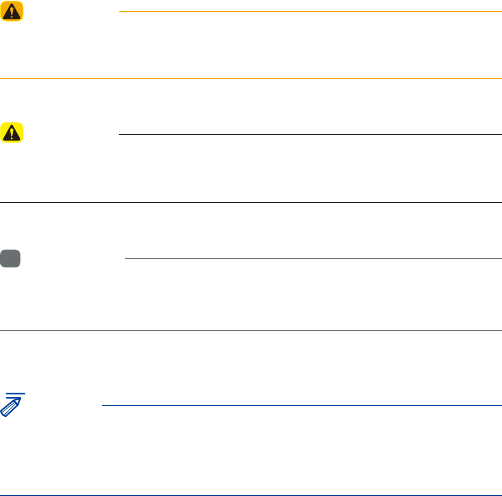
Read the following safety precautions for
your safety
Before using the product, read the contents of this user's manual
carefully and use this product safely.
※ The design and specifications of this product may change without prior
notification for product and service improvement.
The actual images in the vehicle may differ from the illustrations.
For more accurate information about the vehicle, please refer to the
catalogue.
※ This Multimedia system contains open source software, including
without limitation, software distributed and/or modified under the GNU
General Public license, Version 2, June 1991, and the GNU lesser
General Public License, Version 2.1, February 1999.
For additional information and to obtain related materials including
without limitation, the previous referred to licenses and software,
please contact us at MOBIS_OSSrequest@mobis.co.kr
Notations used within this User's Manual
WARNING
• A WARNING indicates a situation in which harm, serious bodily injury or
death could result if the warning is ignored.
CAUTION
• A CAUTION indicates a situation in which damage to your vehicle could
result if the caution is ignored.
i
Information
• Information and tips that provide additional user convenience in using the
product.
NOTICE
• Information on specific features that facilitate proper product use and
functional understanding.
• Information on terminology used within this manual.

2 I Table of Contents
Table of Contents
1. Basic
Warnings and Cautions .............. 1-2
Component Names and
Functions ....................................... 1-4
Head Unit ………………………… 1-4
Steering Wheel Control …………… 1-6
Starting the System for the First
Time ................................................ 1-8
Turning the System On/Off ……… 1-8
System Reset ……………………… 1-8
Battery Warning Message ……… 1-9
Restrictions on Features for Safety
Measures ………………………… 1-9
Home Screen ……………………… 1-10
On-Screen Touch Controls ……… 1-11
2. Radio/Media
FM/AM ............................................ 2-2
DAB(if equipped)/FM, AM .......... 2-3
USB .................................................. 2-5
Before Playing a USB MP3 ……… 2-5
Supported USB music
specifications ……………………… 2-7
USB Music ………………………… 2-8
iPod .............................................. 2-11
Using iPod Devices ……………… 2-11
iPod …………………………………2-15
AUX ............................................... 2-18
Connecting an External Device …2-18
Bluetooth® Audio ........................ 2-19
Bluetooth connections …………… 2-20
3. Bluetooth
Before Using the Bluetooth®
Handsfree ...................................... 3-2
What is
Bluetooth
®
Wireless
Technology? ……………………… 3-2
Precautions for Safe Driving …… 3-2
CAUTIONS upon Connecting
Bluetooth® Phone ………………… 3-3
Bluetooth Connection ................. 3-4
Pairing a New Device …………… 3-4
Connecting Bluetooth Devices…… 3-4
Disconnecting Bluetooth
Devices …………………………… 3-5
Deleting Bluetooth Devices ……… 3-5
Bluetooth Phone .......................... 3-6
Phone Status Icons ……………… 3-6
Dial ………………………………… 3-7
Accept/Reject Call ………………… 3-7
Using the Menu During
a Phone Call ……………………… 3-8
Call History ………………………… 3-9
Contacts …………………………… 3-10
Favourites ………………………… 3-11

Table of Contents I 3
00
4. Other Features
Camera.......................................... 4-2
Steering-linked camera …………… 4-3
5. Settings
Settings ........................................... 5-2
Sound settings .............................. 5-2
Display settings ............................. 5-3
Bluetooth settings ......................... 5-3
Bluetooth connections …………… 5-3
Auto connection priority ………… 5-4
System Bluetooth info …………… 5-4
Phone projection settings........... 5-5
Custom button settings ............... 5-5
Home screen settings ................. 5-5
Date/Time settings ...................... 5-6
Language settings ...................... 5-6
Keyboard settings ........................ 5-6
Screensaver settings ................... 5-7
Advanced settings ...................... 5-7
System info .................................... 5-7
System Update …………………… 5-8
6. Appendix
Product Specification.................. 6-2
Troubleshooting ........................... 6-3
FAQ ................................................. 6-6
About Pairing Mobile Phones …… 6-6
About Making/Answering
Phone Calls ……………………… 6-7
About
Bluetooth
® Wireless
Technology/Multimedia System Use
Environment ……………………… 6-7
Important Safety Information ..... 6-8
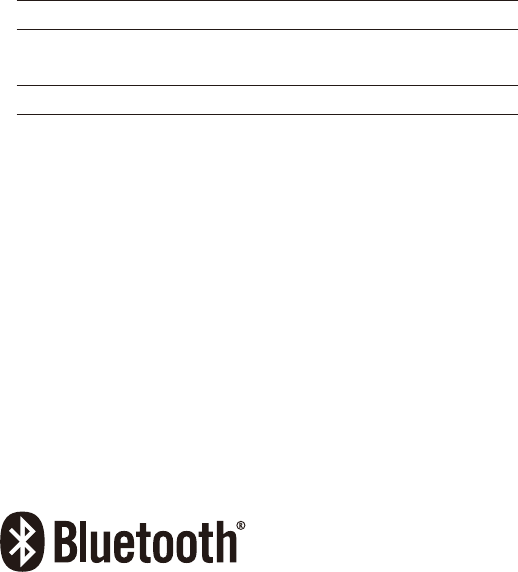
iPod®
iPod® is a registered trademark of Apple Inc.
Bluetooth®
Wireless Technology
The
Bluetooth
® word mark and logos are registered trademarks owned
by Bluetooth SIG, Inc. and any use of such marks by Kia is under license.
Other trademarks and trade names are those of their respective owners.
A
Bluetooth
®
Wireless Technology enabled cell phone is required to use
Bluetooth
®
Wireless Technology.

1-2 I Basic
Safety Warnings
• Do not stare at the screen while driv-
ing. Staring at the screen for prolonged
periods of time could lead to traffic acci-
dents.
• Do not disassemble, assemble, or mod-
ify the Multimedia system. Such acts
could result in accidents, fire, or electric
shock.
• Heed caution not to spill water or intro-
duce foreign objects into the device.
Such acts could lead to smoke, fire, or
product malfunction.
• If you use phone related functions while
driving, you will find it difficult to concen-
trate on operating the vehicle and the
current traffic conditions, so the possibil-
ity of an accident may increase. Please
use phone related functions only when
parked.
• Please refrain from use if the screen
is blank or no sound can be heard as
these signs may indicate product mal-
function. Continued use in such con-
ditions could lead to accidents (fires,
electric shock) or product malfunctions.
• Do not touch the antenna during thun-
der or lightening as such acts may lead
to lightning induced electric shock.
• Do not stop or park in parking-restricted
areas to operate the product. Such acts
could lead to traffic accidents.
• For most Audio and multimedia modes,
the display will not operate when the
vehicle is in motion. For your safety, first
park the vehicle to watch or view the
screen.(The screen will only operate
when the parking brake is ON for man-
ual transmission vehicles and when the
parking brake is ON or the gearshift is in
the P (PARK) position for automatic.)
• Some functions other than the one
mentioned above cannot be used while
driving. These functions operate only
when the vehicle is parked.
Basic Warnings and Cautions

Warnings and Cautions I 1-3
01
Safety Cautions
Pay attention to traffic conditions while
driving.
• Operating the device while driving could
lead to accidents due to a lack of atten-
tion to external surroundings. First park
the vehicle before operating the device.
In addition, the touch screen may not
work for some functions when the vehi-
cle is in motion. The touch screen fea-
ture will be supported once the vehicle
has stopped.
• Adjust the volume to levels that allow
the driver to hear sounds from outside
of the vehicle. Driving in a state where
external sounds cannot be heard may
lead to accidents.
• Pay attention to the volume setting when
turning the device on. A sudden output
of extreme volume upon turning the
device on could lead to hearing impair-
ment. (Adjust the volume to a suitable
levels before turning off the device.)
• Turn on the car ignition before using this
device. Do not operate the Multimedia
system for long periods of time with the
ignition turned off as such operations
may lead to battery discharge.
• Upon using the Multimedia system
for more than 10 minutes with the car
engine turned off, the following warning
will be displayed. After 10 minutes, the
warning will be displayed for 5 seconds
every 1 minute.
• Do not subject the device to severe
shock or impact. Direct pressure onto
the front side of the monitor may cause
damage to the LCD or touch screen.
• When cleaning the device, make sure
to turn off the device and use a dry and
smooth cloth. Never use tough materi-
als, chemical cloths, or solvents(alcohol,
benzene, thinners, etc.) as such mate-
rials may damage the device panel or
cause color/quality deterioration. When
experiencing product concerns, inquire
with your place of purchase or service
maintenance centre.
• Prevent caustic solutions such as per-
fume and cosmetic oil from contacting
the dashboard because they may cause
damage or discoloration.
• If the air freshener gets on to audio
system or plastics, then it could cause
the crack due to its chemical reac-
tion. Please be careful when you use
air fresheners near those products.
Especially be careful when you have
attached air freshener on the air vents.
The liquid can be flow down.
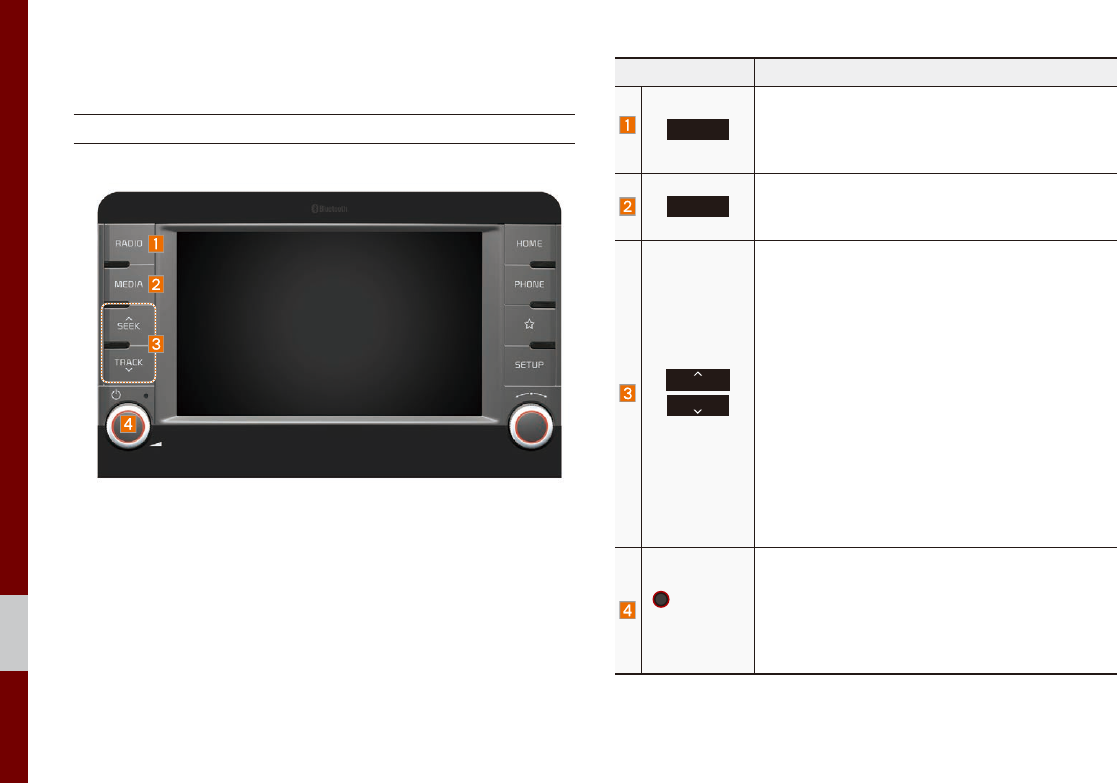
1-4 I Basic
Component Names and Functions
Head Unit
Name Description
RADIO
Moves to DAB(if equipped)/FM or AM mode.
• Each time the key is pressed, the mode
is changed in the following order: DAB(if
equipped)/FM → AM → DAB(if equipped)/FM.
MEDIA
Moves to MEDIA mode.
• If the media is not connected MEDIA mode will
not be activated.
TRACK
SEEK
When the key is pressed shortly (for less than 0.8
seconds),
• DAB(if equipped)/FM or AM mode: Plays the
previous/next frequency.
• MEDIA mode: Changes the track, file or title
(except for AUX).
When the key is pressed and held down (for over
0.8 seconds),
• DAB(if equipped)/FM or AM mode: Moves
quickly through all of the frequencies. The
moment that you release the button, the sys-
tem seeks the next available frequency.
• MEDIA mode: Rewinds or fast forwards the
track or file (except for Bluetooth Audio, and
AUX).
POWER/
VOLUME
• When power is off, press to turn power on.
• When power is on, press and hold for over 0.8
seconds to turn the power off.
• When power is on, press shortly for less than
0.8 seconds to turn Audio off.
• Turn left/right to adjust the volume.
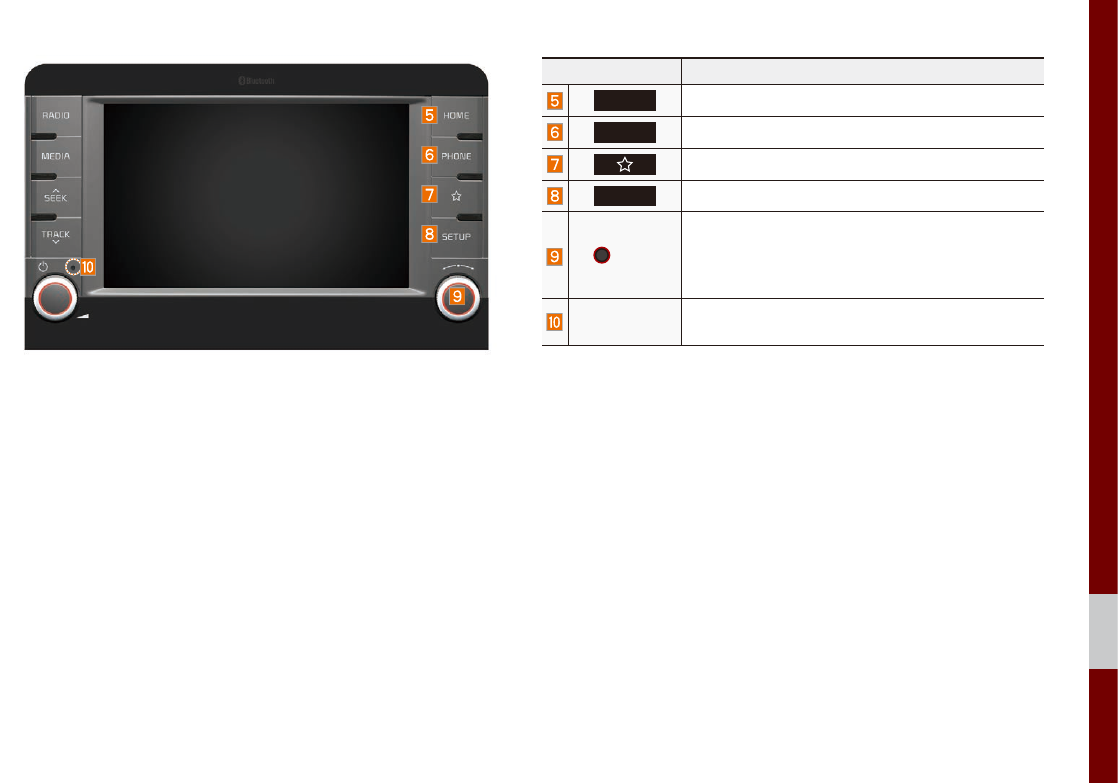
Component Names and Functions I 1-5
01
Name Description
HOME
Displays the HOME screen.
PHONE
Displays the Bluetooth phone mode.
Displays the function set by the user.
SETUP
Moves to the Setup screen.
TUNE
• DAB(if equipped)/FM or AM mode: changes
the frequency.
• MEDIA mode: changes the track, file or title
(except for Bluetooth Audio and AUX).
RESET
Resets the system settings. (Preset radio chan-
nels and other data will not be deleted)
※ The actual image in the vehicle may differ from the illustration.
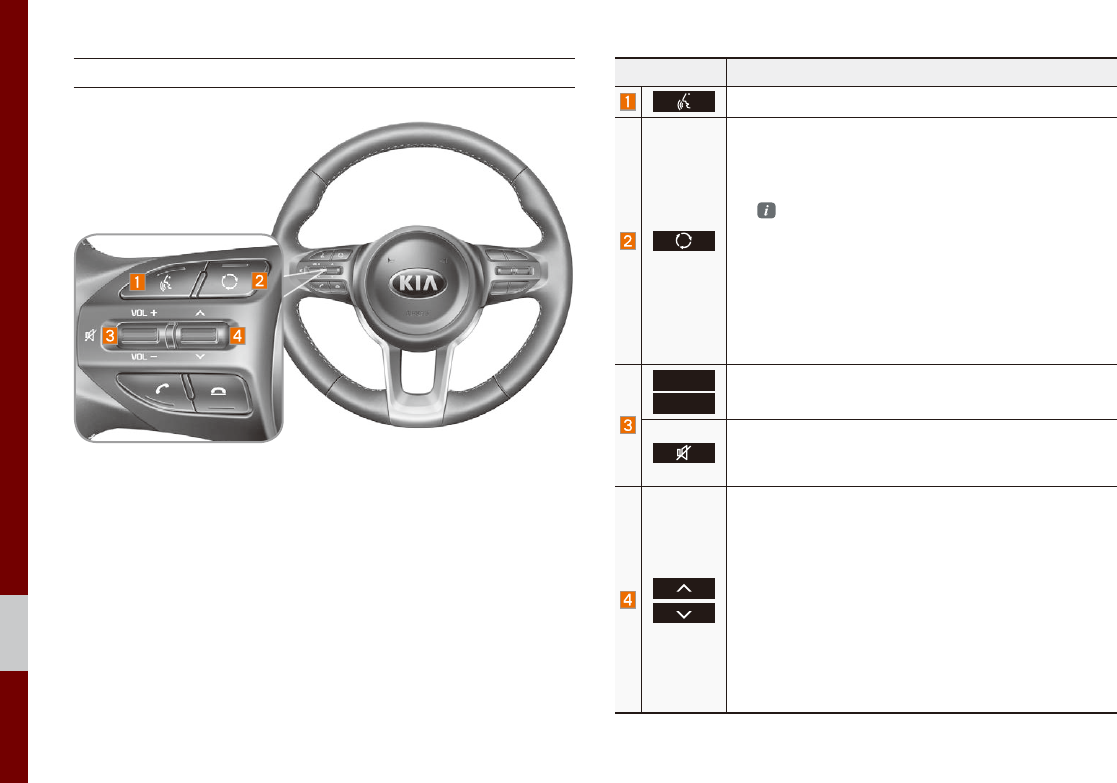
1-6 I Basic
Steering Wheel Control
Name Description
For more details, refer to Phone Projection guide.
• Each time this key is pressed, mode is changed in
the following order: DAB(if equipped)/FM → AM →
USB or iPod → AUX → Bluetooth Audio → DAB(if
equipped)/FM
You can select which mode to use in Advanced
settings.
• If the media is not connected, the corresponding
modes will be disabled.
• Press and hold the key (more than 0.8 seconds) to
turn the Multimedia system on/off.
• When power is off, press the key to turn power
back on.
VOL +
VOL -
Use to adjust the volume of audio or call.
Mutes the audio. (It will be paused in some media
modes.)
Mutes the microphone during a call.
When keys are pressed quickly. (less than 0.8 seconds)
• DAB(if equipped)/FM or AM mode: searches
broadcast frequencies saved to Presets.
• MEDIA mode: changes the track, file or title (except
for AUX).
When keys are pressed and held. (more than 0.8
seconds).
• DAB(if equipped)/FM or AM mode: automatically
searches broadcast frequencies.
• MEDIA mode: quickly looks up songs (except for
AUX and Bluetooth audio files).
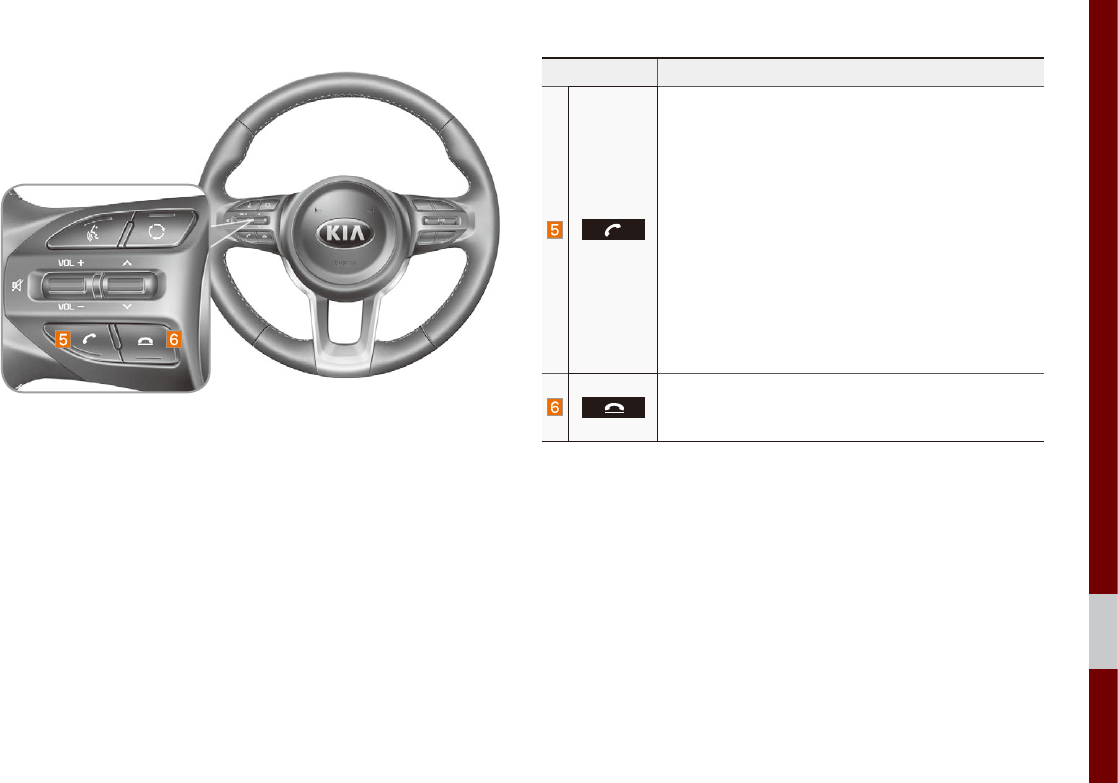
Component Names and Functions I 1-7
01
Name Description
When pressed quickly. (less than 0.8 seconds)
• When pressed in the dial screen, makes a call
• When pressed in the incoming call screen,
answers the call
• When pressed during call waiting, switches to
waiting call (Call Waiting)
When pressed and held. (more than 0.8 seconds)
• When pressed in Bluetooth
®
Hands-free, redials
the last dialled call
• When pressed during a Bluetooth
®
Hands-free
call, switches call back to mobile phone (Private)
• When pressed while calling on the mobile phone,
switches call back to Bluetooth
®
Hands-free (oper-
ates only when Bluetooth
®
Hands-free is connected)
• When pressed during a call, ends the phone call
• When pressed in the incoming call screen, rejects
the call
※ The actual image in the vehicle may differ from the illustration.
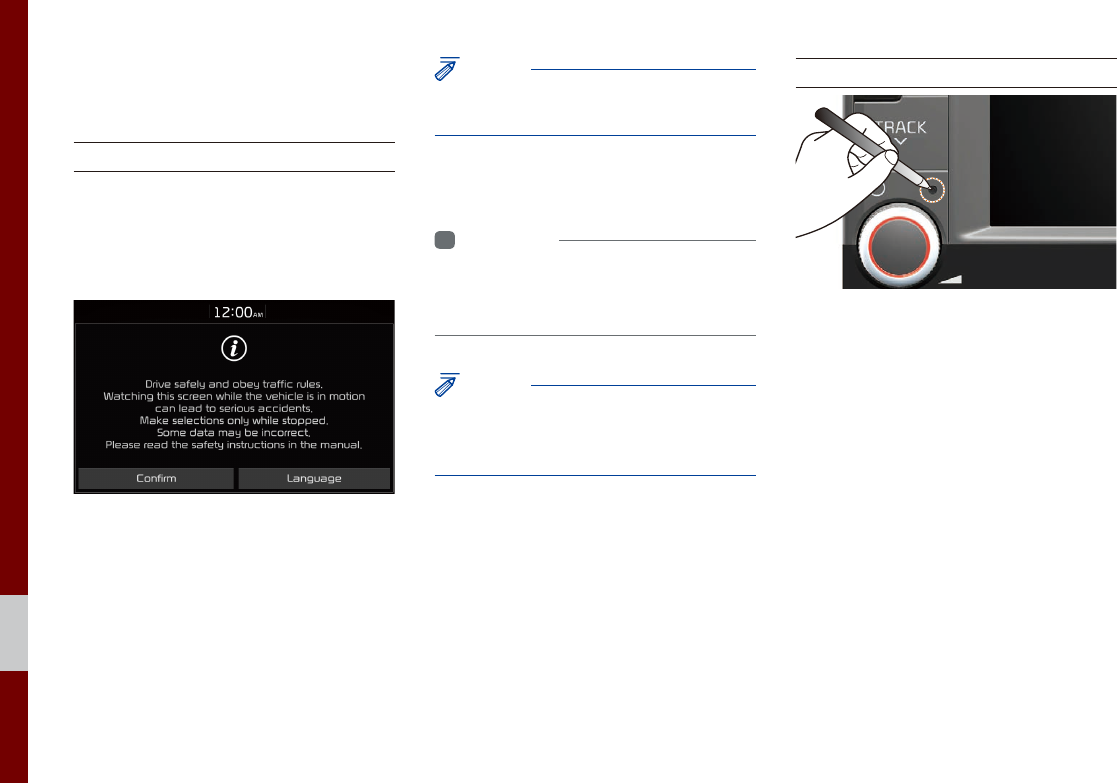
1-8 I Basic
Starting the System for
the First Time
Turning the System On/Off
Press the engine start button or set the
ignition key to On or ACC. Each time you
turn on the system, a boot logo and safety
warning will appear.
Pressing the power key on the head unit
will display the safety guide.
NOTICE
• Cannot operate the system while it is
booting up.
Pressing and holding the power key on the
head unit will turn off the system.
i
Information
• If you turn off the system during a phone call
using the Hands-free feature, then the call will
automatically switch to your mobile phone.
NOTICE
• Check the volume when turning on the
system. Before turning on the system, adjust
the volume to a reasonable level.
System Reset
The System Reset function restores the
system when it is not operating correctly.
Press and hold the RESET key for a sec-
ond or longer. (It is recommended that you
press the RESET key using a tool, such as
a pin or a clip.)
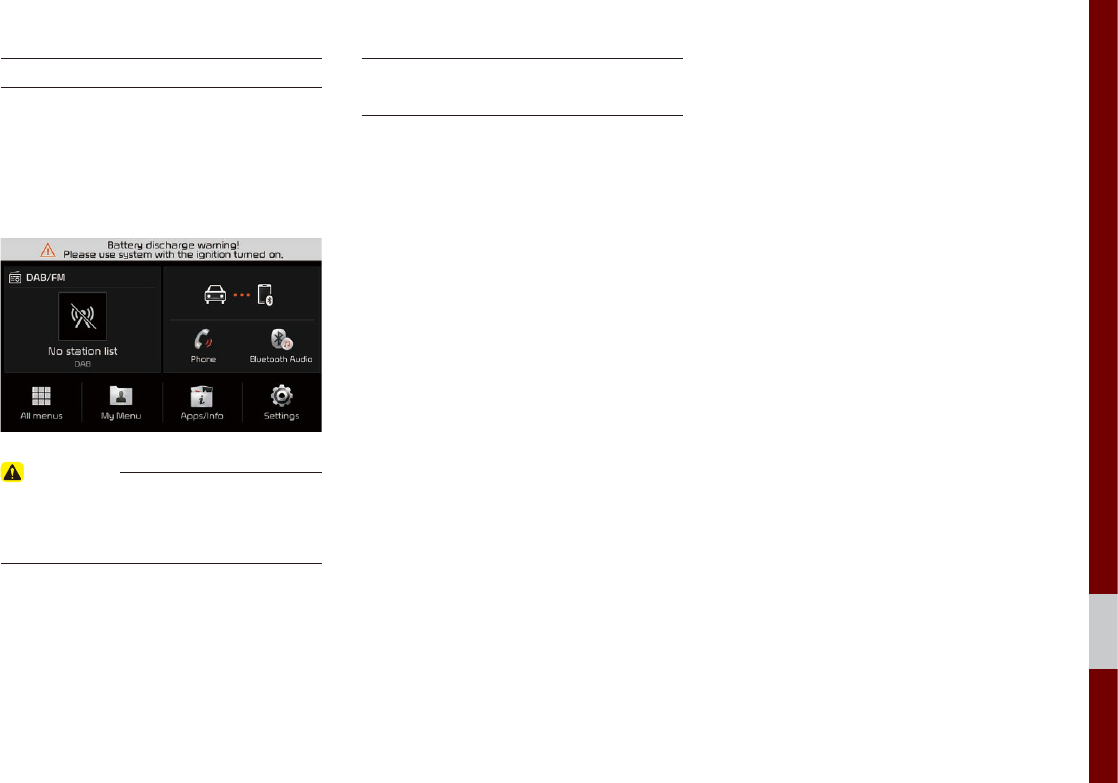
Starting the System for the First Time I 1-9
01
Battery Warning Message
Always use the system while the car
engine is running. If you turn on the sys-
tem while the engine is off, a battery warn-
ing message will appear. When the engine
starts, the message will disappear.
CAUTION
• If you use the system for a long time with
the engine off, the battery may become
completely discharged.
Restrictions on Features for
Safety Measures
Several features are limited while driving.
The restriction screen will disappear when
shifting gears into P or putting the parking
brake on.
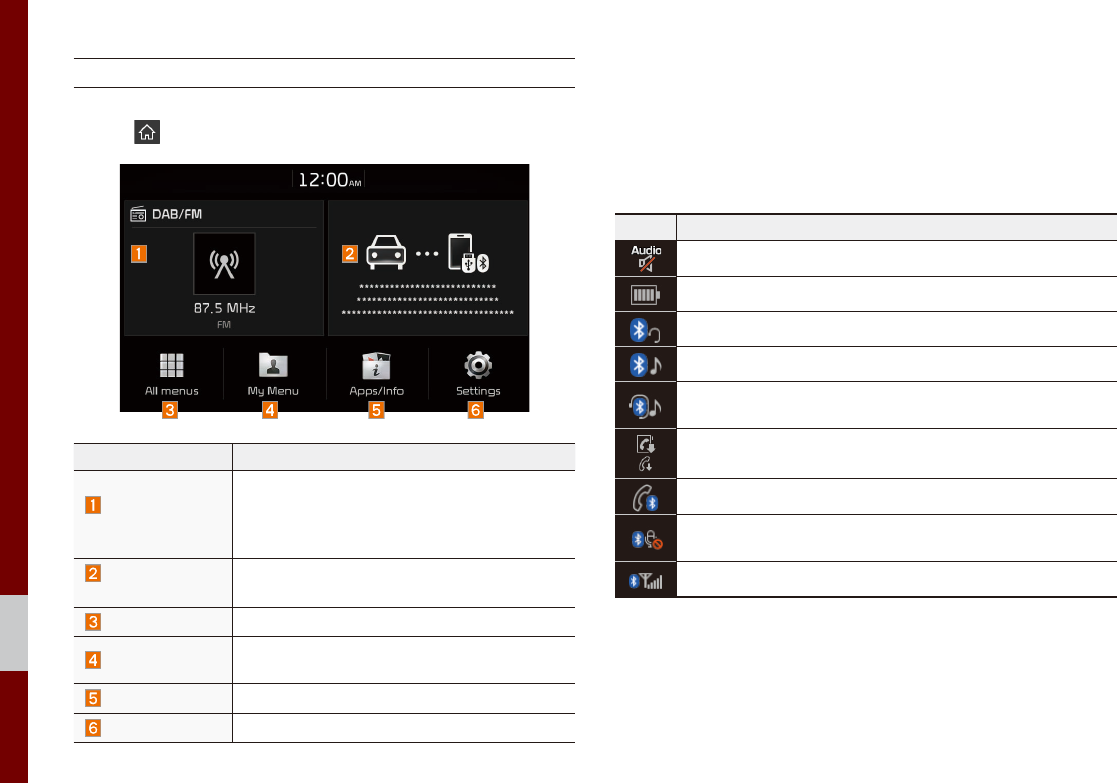
1-10 I Basic
Home Screen
Controls Menu Configuration for the Home Screen
Tap the icon on any screen to display the Home Screen below.
Features Description
Radio/
Media Widget
• Shows brief information on the radio or
media that is now playing.
• Tap the area to move to the mode that you
are listening to.
Phone projection
Widget
Shows any connected devices such as iPod
and Bluetooth.
All menus Shows all of the items in the system menu.
My Menu Add your favourite menus to have quick and
easy access to them.
Apps/Info Moves to the Apps/Info screen.
Settings Moves to the Settings screen.
Information Display on the Status Bar
Displays the date and time, along with the system status shown by
the various icons to the right of the clock.
The icons in the following table indicate the various types of sys-
tem status details and events.
Icon Description
Displayed when the audio is muted.
Displays the remaining battery of the Bluetooth phone.
Displayed when connected to Bluetooth for hands-free.
Displayed when connected to Bluetooth for streaming audio.
Displayed when connected to Bluetooth for streaming audio
and hands-free.
Displayed when downloading contacts or recent calls from the
Bluetooth phone.
Displayed while on a call with the Bluetooth phone.
Displayed when the microphone of the Bluetooth phone is
muted.
Displays the signal strength of the Bluetooth phone.
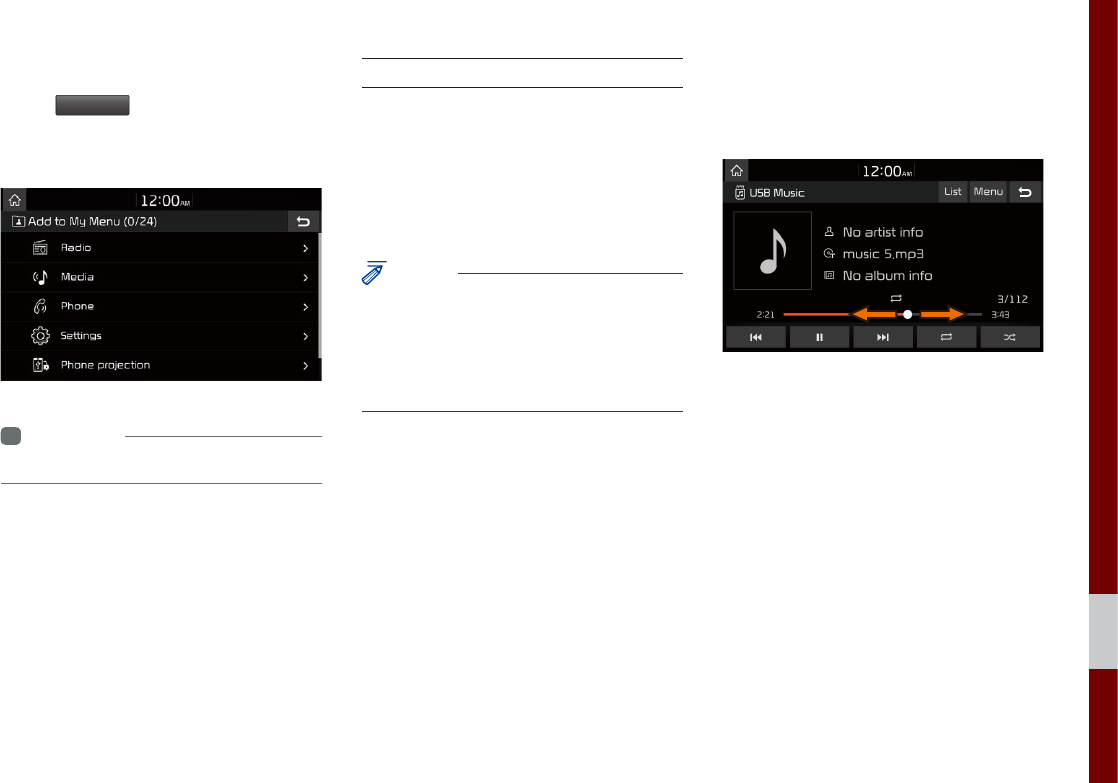
Starting the System for the First Time I 1-11
01
Adding a Feature to My Menu
Select
My Menu
on the Home Screen to
add the most frequently used menus,
change the menu order, or delete menus.
i
Information
• Up to 24 menus can be added to My Menu.
On-Screen Touch Controls
Learn how to touch the screen to operate
the system.
Select
Tap lightly on a menu or an item to select it.
NOTICE
• The system will not recognise your touch if
you wear a glove or other non-conductive
material. Touch the screen using your finger,
an electrostatic touch-screen glove, or a stylus
pen.
Drag & Drop
Select a menu or item you want, then drag
and drop it to where you want to place it.
Drag or touch the slider along the play bar
in the music screens to jump to the point
that you want to play from.
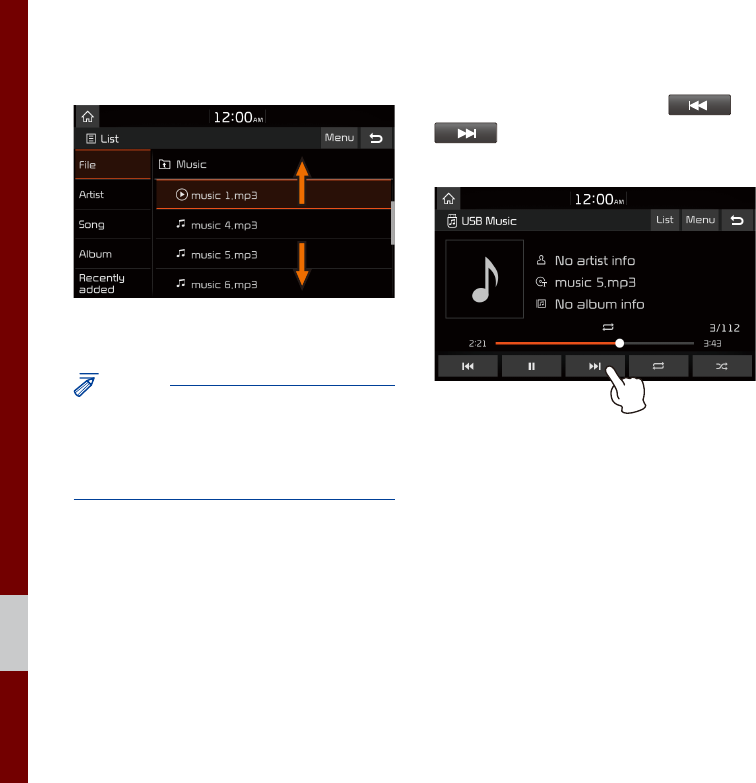
1-12 I Basic
Flick (Quick Scrolling)
Quickly moves up and down in the list.
NOTICE
• Moving the list when there are many items
will display a handler on the right of the
display. You can easily move many items at
a time with the handler.
Select and Hold
Selecting and holding the or
buttons in the music player will
rewind or fast forward the music.

FM/AM
DAB(if equipped)/FM, AM
USB
iPod
AUX
Bluetooth® Audio
part.2 Radio/Media
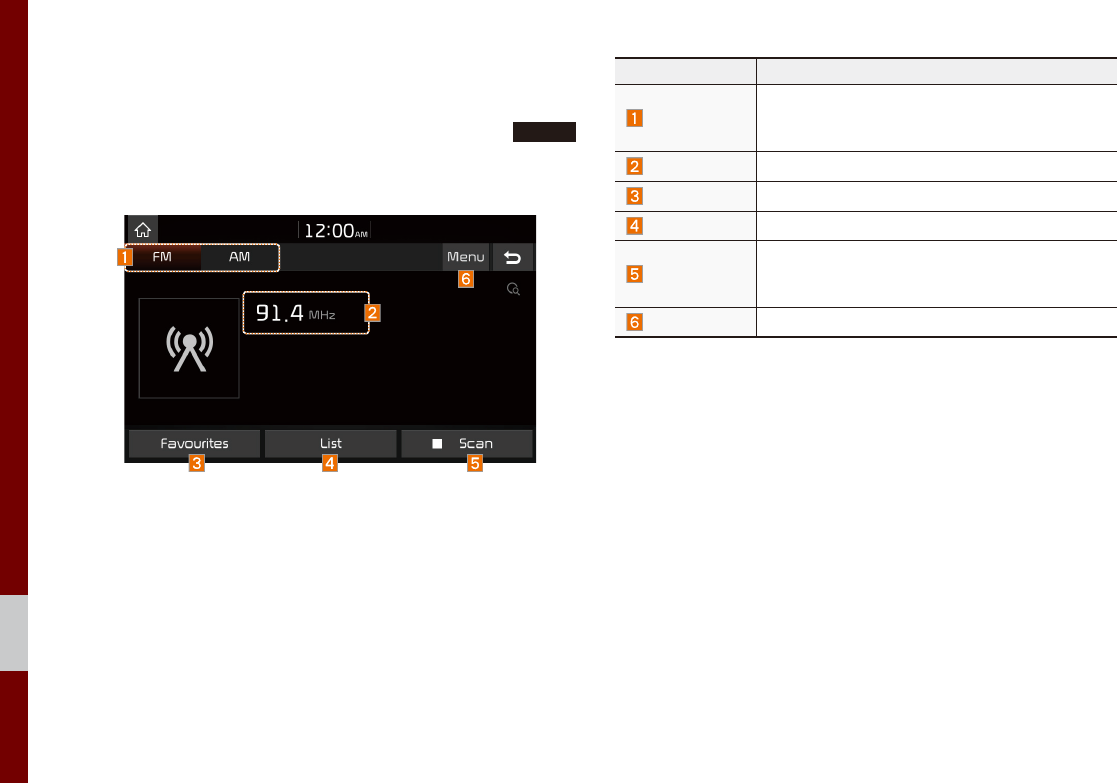
2-2 I Radio/Media
FM/AM
You can access the radio player either by pressing the
RADIO
key or by selecting the Radio menu from All menus on the Home
screen.
Features Description
Mode Display
• Displays currently operating mode.
• Tap the desired mode to change to it in
Radio.
Frequency Displays the current frequency.
Favourites Show the stored Favourites for user selection.
List Moves to the list screen.
Scan
Shortly plays the broadcasts for the frequen-
cies with superior reception for 5 seconds per
item.
Menu Sound settings : moves to the sound settings.
Radio/Media
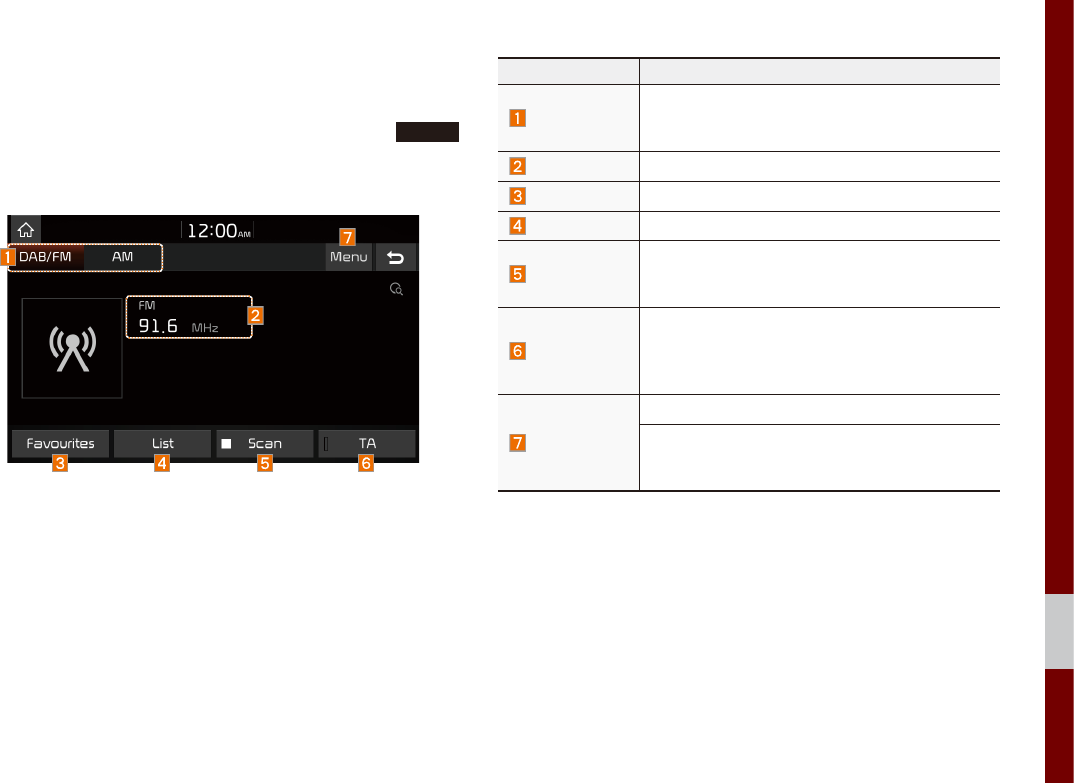
02
DAB(if equipped)/FM, AM I 2-3
DAB(if equipped)/FM, AM
You can access the radio player either by pressing the
RADIO
key or by selecting the Radio menu from All menus on the Home
screen.
Features Description
Mode Display
• Displays currently operating mode.
• Tap the desired mode to change to it in
Radio.
Frequency Displays the current frequency.
Favourites Show the stored Favourites for user selection.
List Takes you to the FM station list.
Scan
Shortly plays the broadcasts for the frequen-
cies with superior reception for 5 seconds per
item.
TA
TA function allows the system to switch to traf-
fic announcement (TA) from the current source.
Traffic programmes and announcements can
be automatically received by using TA features.
Menu
• Sound settings : moves to the sound settings.
DAB
• Manual tune FM : moves to the Manual tune FM.
• Regional : Regional auto On/Off.
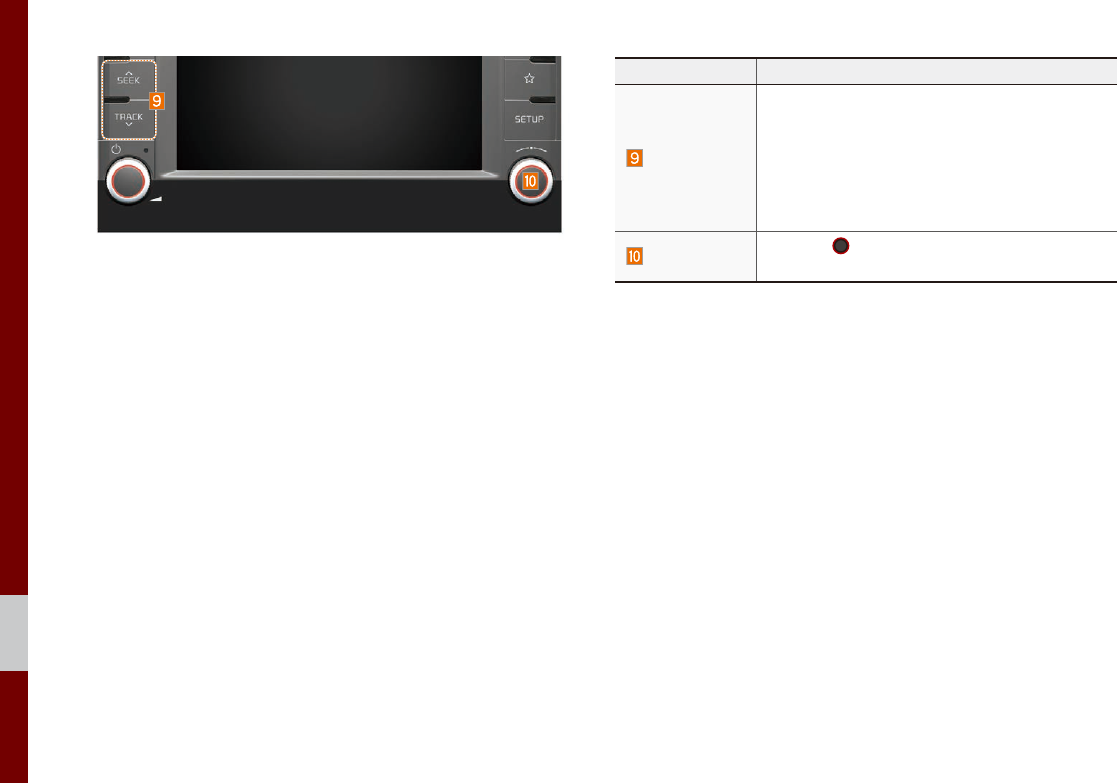
2-4 I Radio/Media
Features Description
SEEK/TRACK
• Pressing this button briefly (less than 0.8 sec-
onds): seeks the previous/next frequency.
• Pressing and holding this button (for over than
0.8 seconds): moves quickly through all of the
frequencies. The moment that you release the
button, the system seeks the next available
frequency.
TUNE Turn the
TUNE
knob to manually seek avail-
able frequencies.

USB I 2-5
02
USB
Before Playing a USB MP3
Connect the USB device after turning on the engine. The USB
device may become damaged if it is already connected when the
ignition is turned on.
• Files that are not standard format music files will not be played.
• For MP3/WMA/OGG files, only music files with compression
rates between 8Kbps to 320Kbps can be played.
• Heed caution to static electricity when connecting/disconnecting
external USB devices.
• Encoded MP3 Players will not be recognised when connected
as an external device.
• When connecting an external USB device, the device may not
properly recognise the USB is in some states.
• Only products formatted with byte/sectors under 64Kbyte will be
recognised.
• USB devices, formatted to the FAT12, FAT16, or FAT32 file sys-
tem are recommended. File systems other than FAT12, FAT16,
FAT32, exFAT, and NTFS are not supported.
• Some USB devices may not be supported due to compatibility
issues.
• Take caution so that the USB connector does not come in con-
tact with body parts or objects.
• Repeated connecting/disconnecting of USB devices within short
periods of time may result in product malfunction.
• Make sure to connect/disconnect external USB devices with the
audio power turned off.
• The amount of time required to recognise the external USB
device may differ depending on the type, size, or file formats
stored on the USB.
• The use of USB devices for purposes other than playing music
files is prohibited.
• Do not use the USB I/F to charge batteries or USB accessories
that generate heat. Such acts may lead to worsened perfor-
mance or damage to the device.
• The device may not recognise the USB device if separately
purchased USB hubs and extension cables are being used.
Connect the USB directly with the multimedia terminal of the
vehicle.
• When using mass storage USB devices with separate logical
drives, only files saved to the root drive can be played.
• When application programs are installed to specific USBs, files
may not properly play.
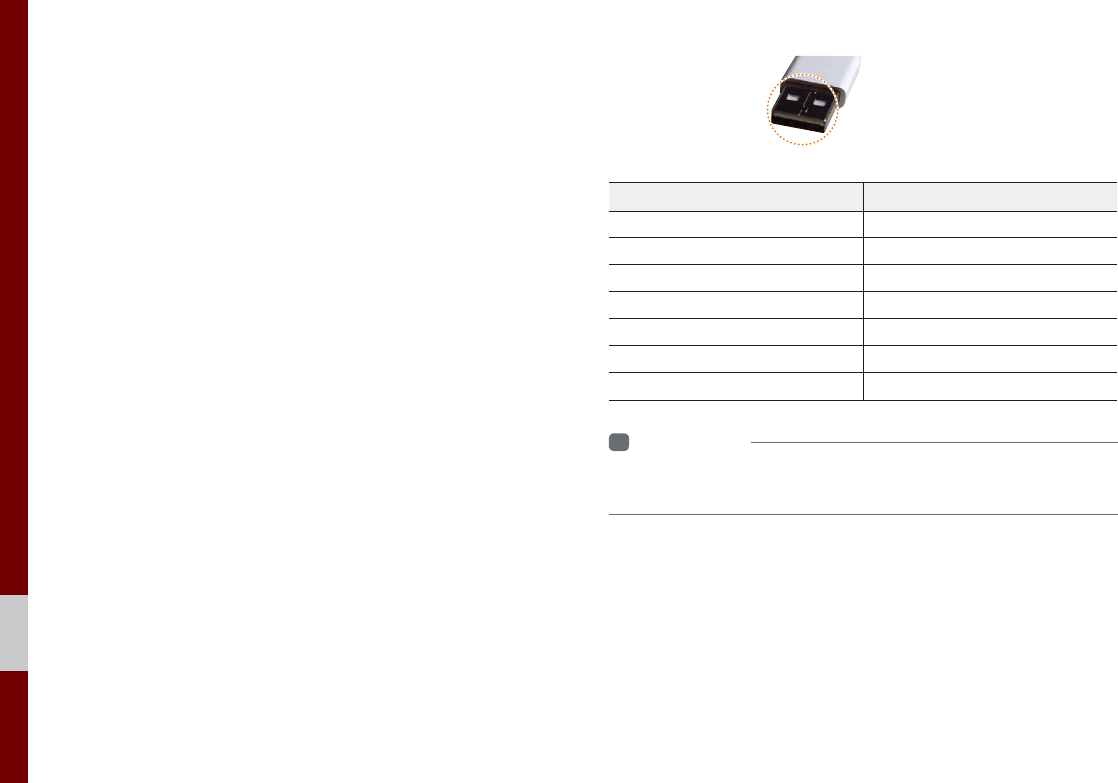
2-6 I Radio/Media
• The device may not operate normally if MP3 Players, cellu-
lar phones, digital cameras, or other electronic devices (USB
devices not recognised as portable disk drives) are connected
with the device.
• Charging through the USB may not work for some mobile
devices.
• The device may not support normal operation when using a USB
memory type besides Metal Cover Type USB Memory.
• The device may not support normal operation when using for-
mats such as HDD Type, CF, or SD Memory.
• Upon playing iPods, please use a dedicated iPod car cable.
• Normal operations cannot be guaranteed when other cables are
being used.
• The device will not support files locked by DRM(Digital Rights
Management).
• USB memory sticks used by connecting an Adaptor (SD Type or
CF Type) may not be properly recognised.
• Only use Plug type connector products, as shown in the figure
below.
• To play USB MP3, the USB device must be connected to the
USB port in the front multibox. The USB port in the centre con-
sole storage (if equipped) is for charging only.
Plug Type Connector
Product Name Manufacturer
XTICK LG
BMK BMK Technology
SKY-DRV Sky Digital
TRANSCEND JetFlash Transcend
Sandisk Cruzer SanDisk
Micro ZyRUS ZyRUS
NEXTIK Digiworks
i
Information
• Problems that occur through use of USB devices not listed within the
above table are not covered by the product warranty.
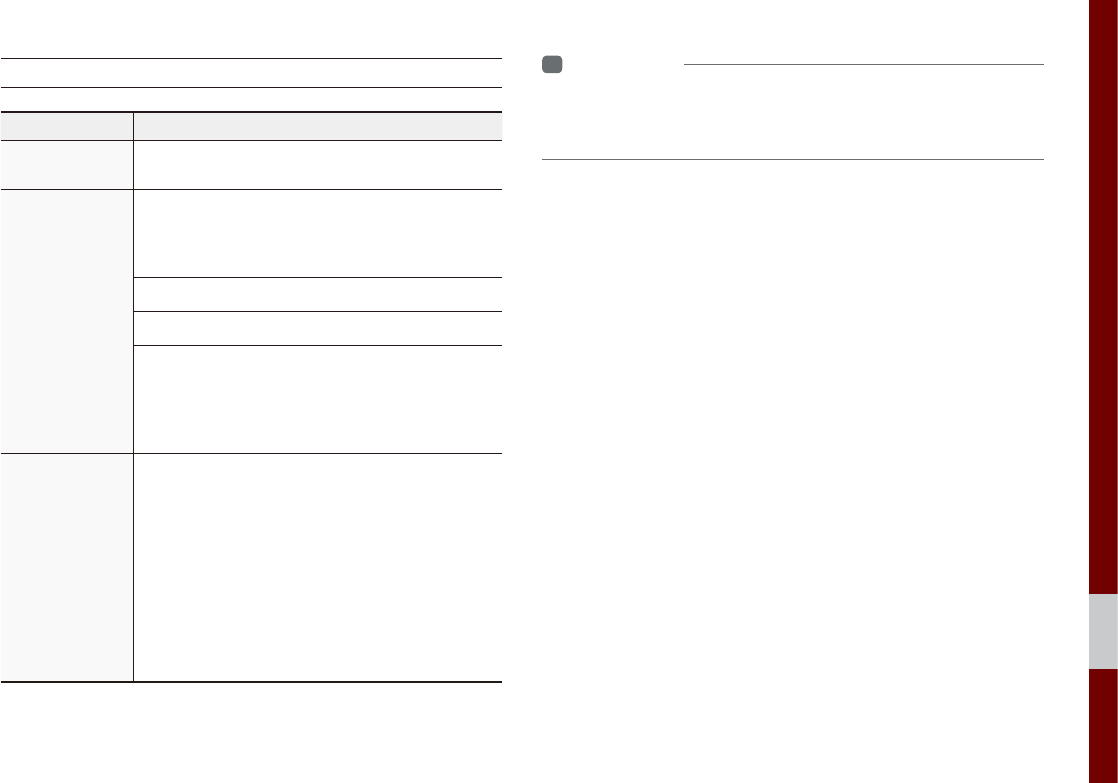
USB I 2-7
02
Supported USB music specifications
Name Description
Audio File
Specification
MPEG-1/2 layer3, OGG (Vorbis), FLAC, WMA
(Standard/Professional)
Recommended
Bit Rates and
Sampling
Frequency
MPEG-1/2 layer3
• 8 kbps to 320 kbps (CBR or VBR), to 48 kHz
• ID3 Tag: Suppor ts ID3v1.0 and ID3v1.1,
ID3v2.3, ID3v2.4 ID3 tags
OGG (Vorbis): From Q-1 to Q10, to 48 kHz
FLAC: 8 bit/16 bit/24 bit, to 48 kHz
WMA
• Standard (0x161): to support L3 Profile: to 385
kbps, to 48 kHz
• Professional (0x162): to support M0b: to 192
kbps, to 48 kHz
Detailed
Specifications
Maximum directory layers: 20 layers
Maximum length of folder name/file name: 255
bytes
Supported characters for folder name/file name:
Alphanumeric characters, Korean standard char-
acter set 2,350 characters, Simplified Chinese
4888 characters
Maximum number of folders which can be stored
onto one USB: 2000 folders (including ROOT)
Maximum number of files which can be stored
onto one USB: 8000
i
Information
• The sound quality of audio files that use bitrates exceeding 192 kbps
cannot be guaranteed. When using files without fixed bit rates, some
features (FF/REW features) may not operate properly.
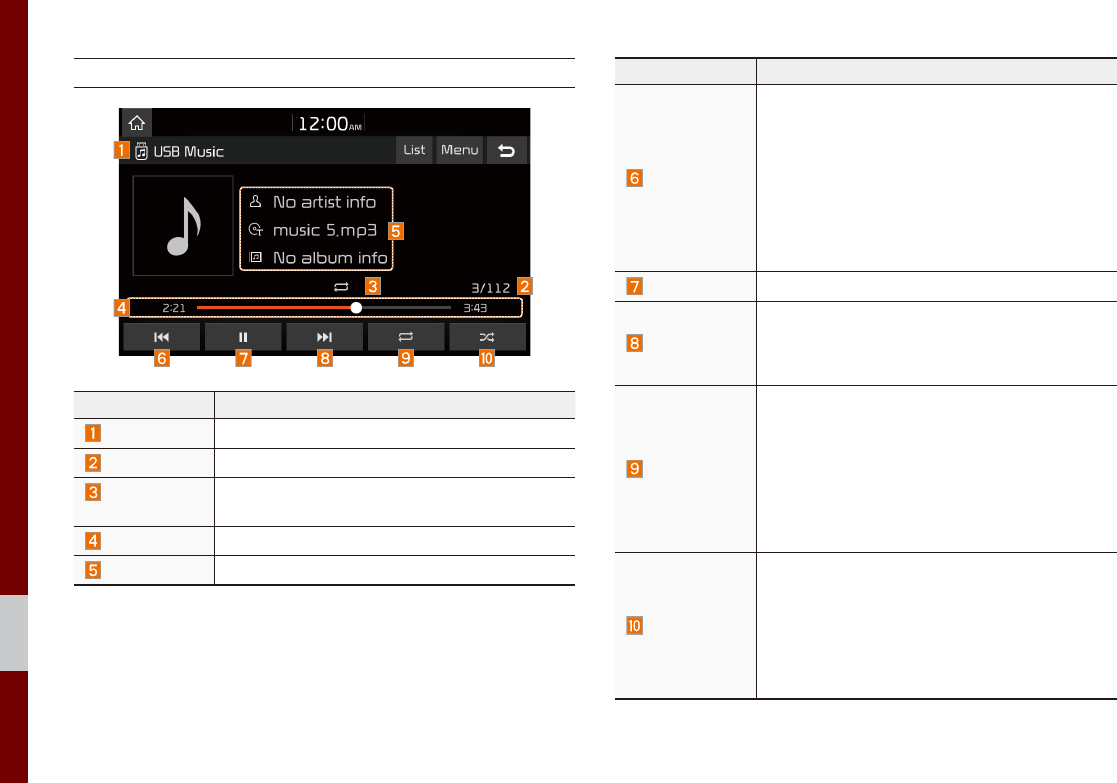
2-8 I Radio/Media
USB Music
Features Description
Mode Displays current operating mode
File Index Shows the current file/total files within the USB
Repeat/
Shuffle
From Repeat/Shuffle, displays the current oper-
ating function
Play Time Displays the current play time/total play time
Song Info Displays the artist/title/album info
Features Description
Previous File
• If button is pressed (less than 0.8 seconds):
moves to the previous file or play the current file
from the beginning (Depends on the play time)
- If play time is less than 3 seconds, moves to
previous file
- If play time is over 3 seconds, play the cur-
rent file from the beginning
• If button is pressed (over 0.8 seconds): it
rewinds the track
Play/Pause Plays/pauses the current file
Next File
• If button is pressed (less than 0.8 seconds):
moves to the next file
• If button is pressed (over 0.8 seconds): it
fast-forwards the track
Repeat
Repeats the current file.
• If select the file in the file tab on the list screen:
select this button to switch between repeating
the current file, repeating folder, and repeating
all files.
• If select the file in the other tabs on the list
screen: select this button to switch between
repeating the current file and repeating all files.
Shuffle
Plays files in random order.
• If select the files in the file tab on the list
screen: select this button to switch between
shuffle folder, shuffle all, and turning off.
• If select the track in the other tabs on the list
screen: select this button to switch between
shuffle category and turning shuffle off.
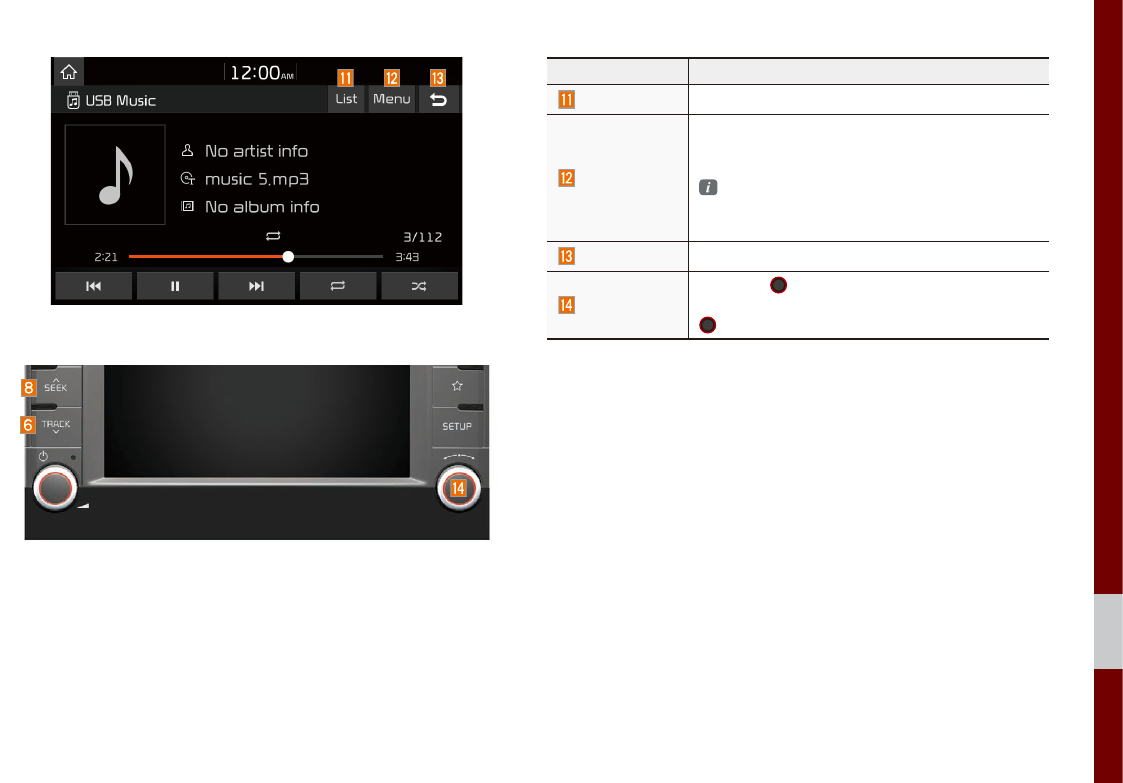
USB I 2-9
02
Features Description
List Moves to the list screen
Menu
• Delete current file: a selected file can be
deleted. Deleted file can be found in the ‘to_
delete’ folder.
This function is only supported when USB
format is compatible with FAT16 or FAT32.
• Sound settings: moves to the sound settings.
Back Button Converts to basic mode screen
TUNE
Turn the
TUNE
knob to search a desired
track. If the desired track is displayed, press the
TUNE
knob to play the track.
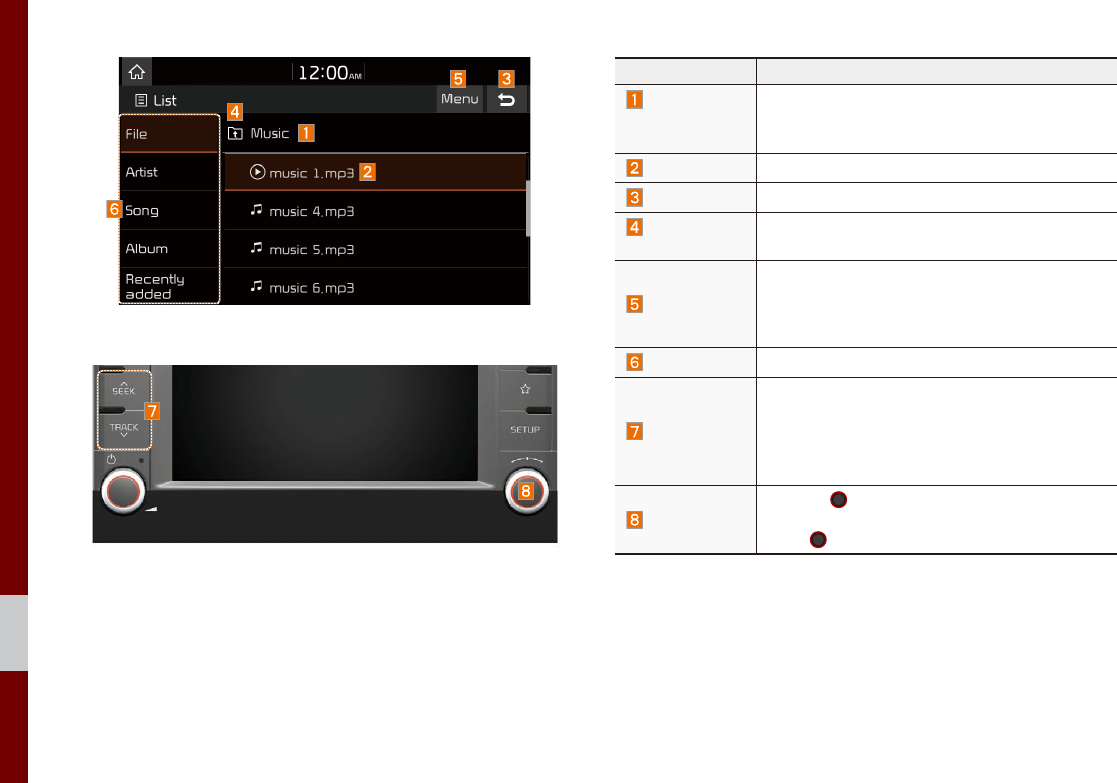
2-10 I Radio/Media
Features Description
Folder/
Category
Name
Displays folder/category name in the list
Current Song Displays current playing file name
Back Button Converts to basic mode screen
Upper Folder/
Category Moves to upper Folder/Category
Menu
Show current track: when moving to a different
list screen, moves to the list page where the cur-
rent file is located (Becomes disabled when the
current list includes the current file)
Search Menu Search songs by the list type
SEEK/TRACK
• If button is pressed (less than 0.8 seconds):
plays previous/next track.
• If button is pressed (over 0.8 seconds): moves
to play screen, and then it will rewind or
fast-forward the track.
TUNE
Turn the
TUNE
knob to move the focus to the
previous/next list. If the desired track is displayed,
press
TUNE
knob to play the track.
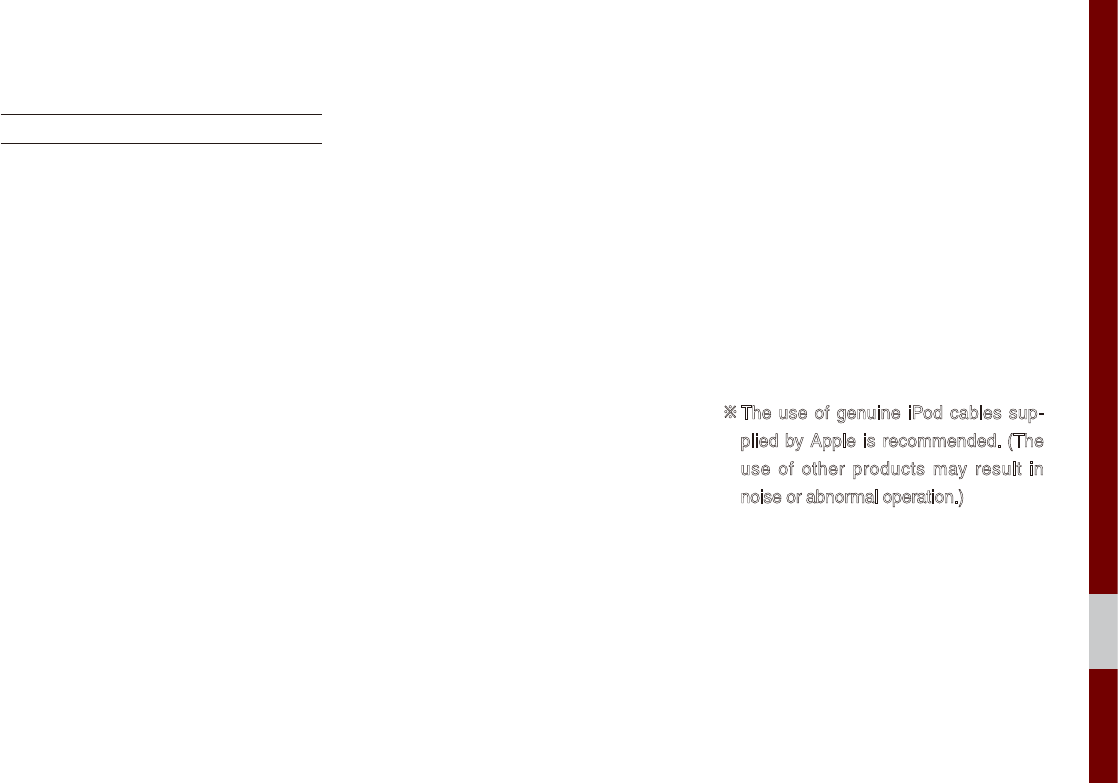
iPod I 2-11
02
iPod
Using iPod Devices
• iPod is a registered trademark of Apple
Inc.
• iPod mode will not operate if the con-
nected iPod cannot be recognised due
to operation of unsupported versions
that do not support related protocols,
iPod abnormalities, or iPod device
defects. Some iPods with unsupported
communication protocols may not prop-
erly operate with the Multimedia system.
• For fifth generation iPod Nano devices,
the iPod may not be recognised when
the battery level is low. Please charge
the iPod for use.
• Search/play orders shown within the
iPod device may differ with the orders
shown within the Multimedia system.
• If the iPod malfunctions due to an iPod
device defect, reset the iPod and try
again. (To learn more, refer to your iPod
manual)
• If repeatedly connect and disconnect
iPod/iPhone to the Multimedia system
with USB cable in short time, it may
cause abnormal operation.
• The time for recognition of iPod/iPhone
may vary depending on device type,
firmware version and iOS version.
• For some iPod Touch and iPhone
devices, connecting Bluetooth® while the
iPod is operating may result in discon-
tinued iPod sound. When such devices
with Bluetooth® support are connected,
this problem occurs as the sound source
is changed from the Dock Connector
(USB connector cable) to Bluetooth.
• To prevent this symptom, Bluetooth
Audio function in the Multimedia system
is limited if iPod/iPhone is connected
to the system through both cable and
Bluetooth. To listen to the iPod sound,
use either iPod menu with USB connec-
tion or Bluetooth Audio with Bluetooth
connection.
• To listen to the iPod sound, reconnect
the USB cable or change the audio out-
put settings in iPod/iPhone to Dock.
• In order to use the iPod while operating
the keys, you must use a dedicated iPod
cable. (the cable that is supplied when
purchasing iPod/iPhone products)
※ During ACC ON state, connecting the
iPod through the iPod cable (The cable
that is supplied when purchasing iPod/
iPhone product.) will charge the iPod
through the head unit.
※ The use of genuine iPod cables sup-
plied by Apple is recommended. (The
use of other products may result in
noise or abnormal operation.)
※ To play iPod music through cable con-
nection, the iPod/USB cable must be
connected to the USB port in the front
multibox. The USB port in the centre
console storage (if equipped) is for
charging only.

2-12 I Radio/Media
• When connecting with the iPod cable,
make sure to fully insert the jack to pre-
vent communication interference. If the
iPod is connected to the vehicle while it
is playing, a high pitch tone may sound
for about 1 to 2 seconds immediately
after connection. If possible, connect
the iPod to the vehicle with the iPod
stopped/paused.
• Within iPhones, streaming audio and
iPod control may occasionally conflict.
If problems persist, remove the iPhone
and connect again.
• When connecting to iPod Nano/Classic,
the Kia Motors logo appears on the
Apple device. For the iPod Nano 6 gen-
eration, however, the logo image does
not appear since it is not supported.
Also, all iPhone and iPod Touch prod-
ucts do not support this function.
• In Apple’s iOS 6.0 version or later,
Podcast and Audiobook media files
are designed to be played with the
Podcasts and iBooks applications spe-
cifically designed for Apple products. If
the Apple device does not provide the
Podcast and Audiobook lists, the playlist
may not be displayed and played in the
iPod mode.
• If the Apple Podcasts and iBooks apps
are not installed on the Apple device, but
the Apple device provides the Podcast
and Audiobook lists, you can play files in
other categories in iPod mode.
• The screen of multimedia system can
be different when you run other music
players (e.g. iHeartRadio) on your con-
nected device.

iPod I 2-13
02
• While using a connected iPhone/iPod
Touch device, it may not operate nor-
mally if the user changed some func-
tions in the device.
• When calling with an iPhone connec-
tion, song may stop playing due to an
Apple device feature. If sound does
not resume after the call is terminated,
check the device status.
• If lots of songs have the same informa-
tion, skipping may occur when previous/
next song is executed due to an Apple
device feature. Also problems may
occur depending on device type or iOS
version.
• If lots of songs have the same informa-
tion, it may occur difference of playing
songs between the Multimedia system
and Apple device. Reset the device or
delete the same songs in the Apple
device using iTunes.
• If you control pause, repeat, shuffle,
or seek songs when the play time is
less than 3s before finished playing, it
may occur difference of playing song
between the Multimedia system and
Apple device. Access to iPod music from
another mode or pause a song and then
play a song again in Apple device.
• If the iPhone/iPod Touch supports
Bluetooth, it is unable to use Bluetooth
Audio if the Apple device that is con-
nected to the Multimedia system
through both USB connection and
Bluetooth. Disconnect the USB connec-
tion then use Bluetooth Audio.
• If iPod/iPhone connected to the
Multimedia system through both USB
and AUX. iPod/iPhone keeps output
sound via AUX, thus it may occur sound
will not output in iPod mode.
• If AUX cable connected to iPod/iPhone
but not connect to the Multimedia sys-
tem, it may occur sound will not output
in iPod mode due to iPod/iPhone’s fea-
ture. Especially, if you use AUX cable
like pictures, this problem may occur.
• Disconnect AUX cable from iPod/iPhone
first, then connect to the Multimedia
system via USB. Or change settings to
“Dock” in iPod/iPhone.
• If connect to the Multimedia system
while podcast or iTunes music down-
loading to iPod/iPhone, it may occur
some problems when you select song
in the list. Reconnect iPod/iPhone to the
Multimedia system when downloading
is finished or the file deleted.
• If connect to the Multimedia system
while sync, it may occur some problems.
Try to use iPod/iPhone connection after
sync complete. (To learn more, refer to
your iPod manual)
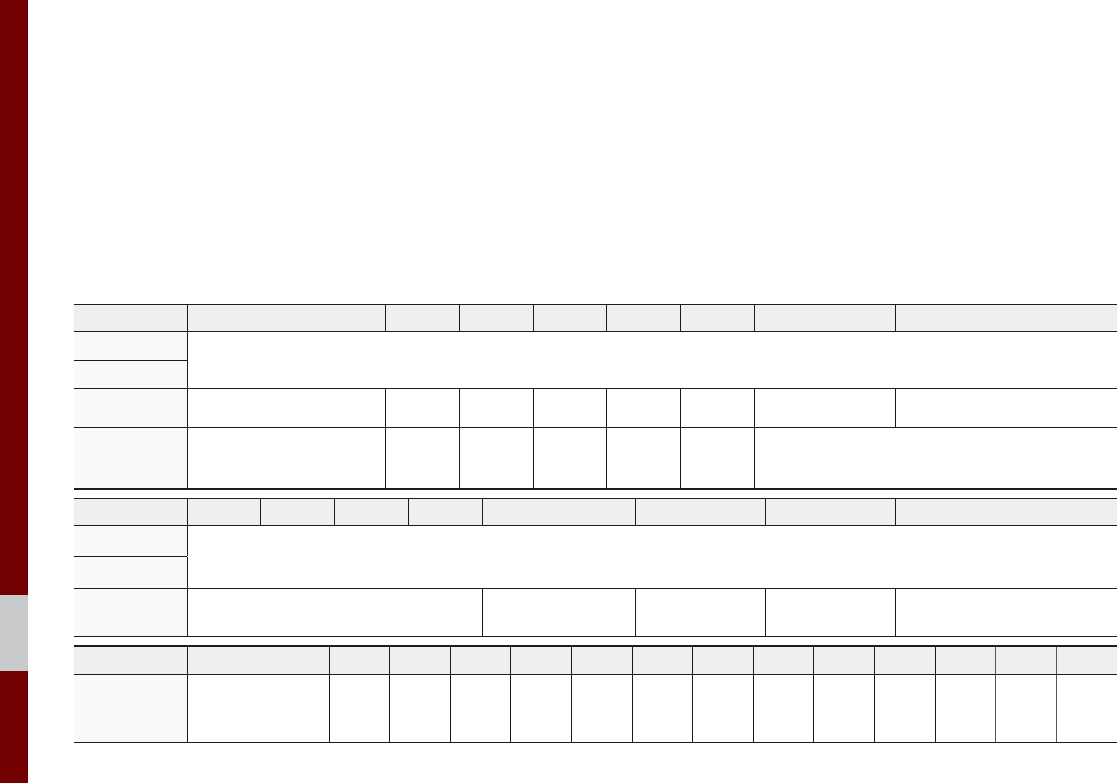
2-14 I Radio/Media
• iPhone and iPod Touch devices are
guaranteed to work normally on iOS
9.3.2 or below. However, they may not
work normally on future iOS versions
as their operations have not yet been
tested.
• We recommend that your Apple device
uses the latest firmware since some
problems may occur due to an outdated
firmware or other software related
issues.
Type 1G 2G 3G 4G 5G 6G 6.5G 7G
iPod Mini Not Supported
iPod Shuffle
iPod Nano ○ ○○○○○Not released ○
iPod Touch ○
(iOS 1.1 not supported) ○○○○○ Not released
Type 1G 2G 3G 4G 5G 6G 6.5G 7G
iPad ○ (Unable to charge, Not verified, Normal operation not guaranteed)
iPad Mini
iPod Classic Not Supported ○
(iPod with Video)
○
(iPod Classic)
○
(iPod Classic) Not released
Type 3G 3GS 44S 55C 5S 66+ 6S 6S+ SE 77+
iPhone
Not verified,
Normal operation
not guaranteed
○○○○○○○○○○○○○
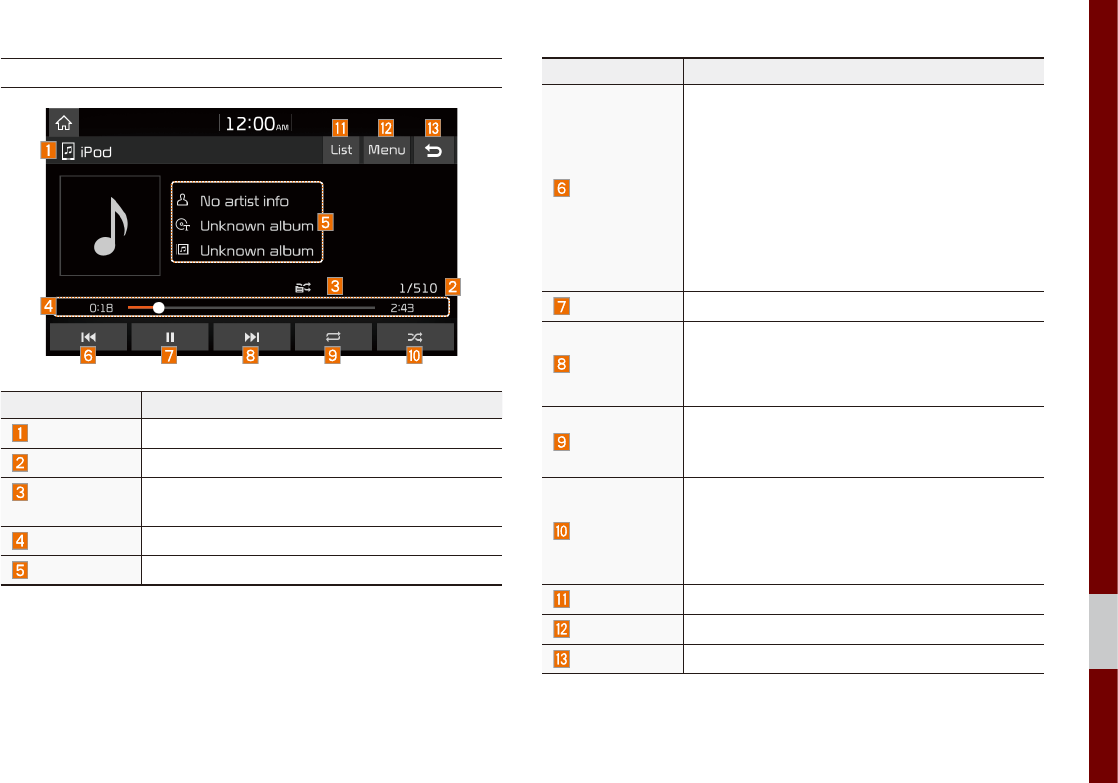
iPod I 2-15
02
iPod
Features Description
Mode Displays current operating mode
Song Index Shows the current song/total songs
Repeat/
Shuffle
From Repeat/Shuffle, displays the current oper-
ating function
Play Time Displays the current play time/total play time
Song Info Displays the artist/title/album info
Features Description
Previous File
• If button is pressed (less than 0.8 seconds):
moves to the previous file or play the current
file from the beginning (Depends on the play
time)
- If play time is less than 3 seconds, moves to
previous file
- If play time is over 3 seconds, play the cur-
rent file from the beginning
• If button is pressed (over 0.8 seconds): it
rewinds the track
Play/Pause Plays/pauses the current file
Next File
• If button is pressed (less than 0.8 seconds):
moves to the next file
• If button is pressed (over 0.8 seconds): it
fast-forwards the track
Repeat
Repeats the current song.
Select this button to switch between repeating
the current song and repeating all songs.
Shuffle
Plays songs in random order.
Select this button to switch between shuffle cat-
egory and turning shuffle off.
• Shuffle Category: shuffle song in the current
category
List Moves to the list screen
Menu Sound settings: moves to the Sound settings.
Back Button Move to home/previous mode screen
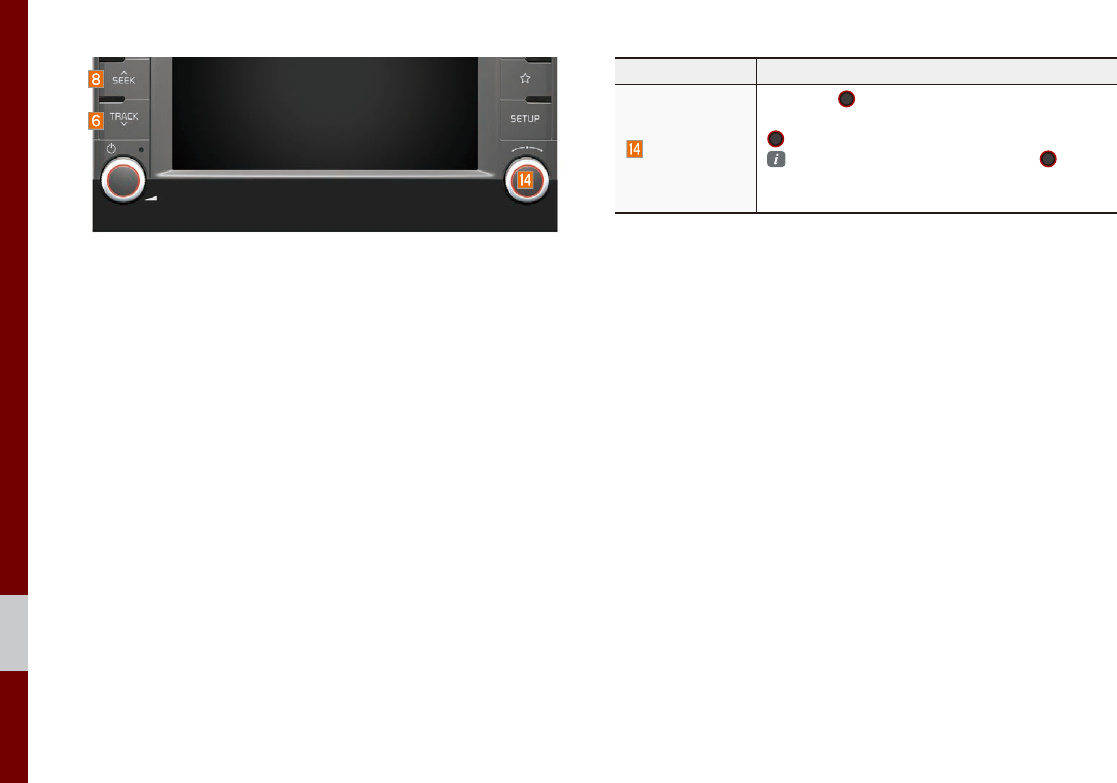
2-16 I Radio/Media
Features Description
TUNE
Turn the
TUNE
knob to search a desired
track. If the desired track is displayed, press the
TUNE
knob to play the track.
If you do not anything with the
TUNE
knob for 5 seconds of searching tracks, the
track info for the current track is restored.
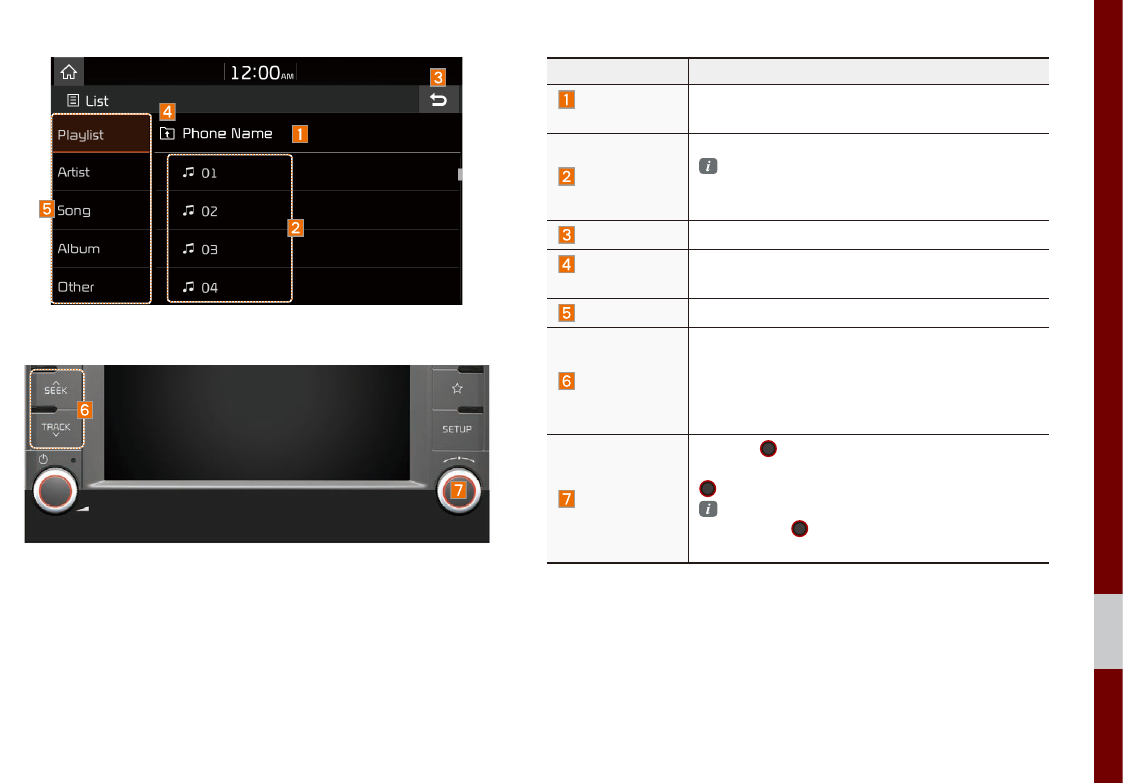
iPod I 2-17
02
Features Description
Category
Name Displays the category name
Category List
Displays the contents of selected category
If there are many items in the list, items are
added in order and the scroll bar on the right
is adjusted accordingly.
Back Button Converts to basic mode screen
Upper
Category Moves to upper category
Search Menu Search songs by the list type
SEEK/TRACK
• If button is pressed (less than 0.8 seconds):
plays previous/next track.
• If button is pressed (over 0.8 seconds):
moves to play screen, and then it will rewind
or fast-forward the track.
TUNE
Turn the TUNE knob to search a desired track.
If the desired track is displayed,
press the
TUNE knob to play the track.
If you do not anything with the knob for 5 sec-
onds, the
TUNE
knob search will be termi-
nated.
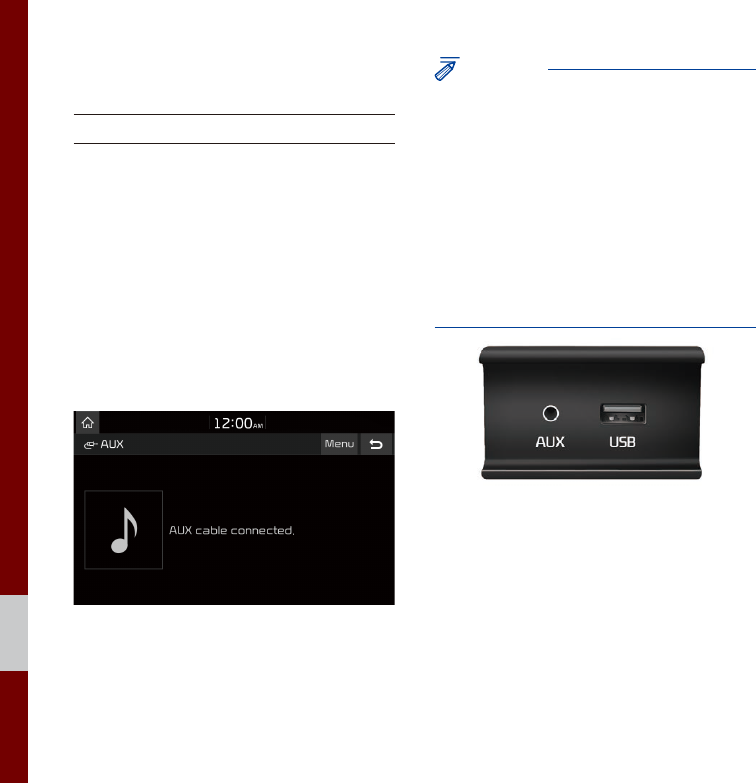
2-18 I Radio/Media
AUX
Connecting an External Device
Connect an external device cable to the
AUX input to automatically switch to AUX
mode. Unplug the cable to automatically
switch back to the previous mode.
AUX mode is available only when an
external device (laptop, MP3 player etc.) is
connected.
The AUX input volume can be adjusted
separately from other AV modes.
NOTICE
• If only a cable is connected to the AUX
without an external device, the mode will
be changed to AUX, but noise may occur.
When an external device is not being used,
remove the connector jack.
• When the external device power is
connected to the power jack, playing the
external device may output noise. In such
cases, disconnect the power connection
before use.
※ The actual image in the vehicle may
differ from the illustration.
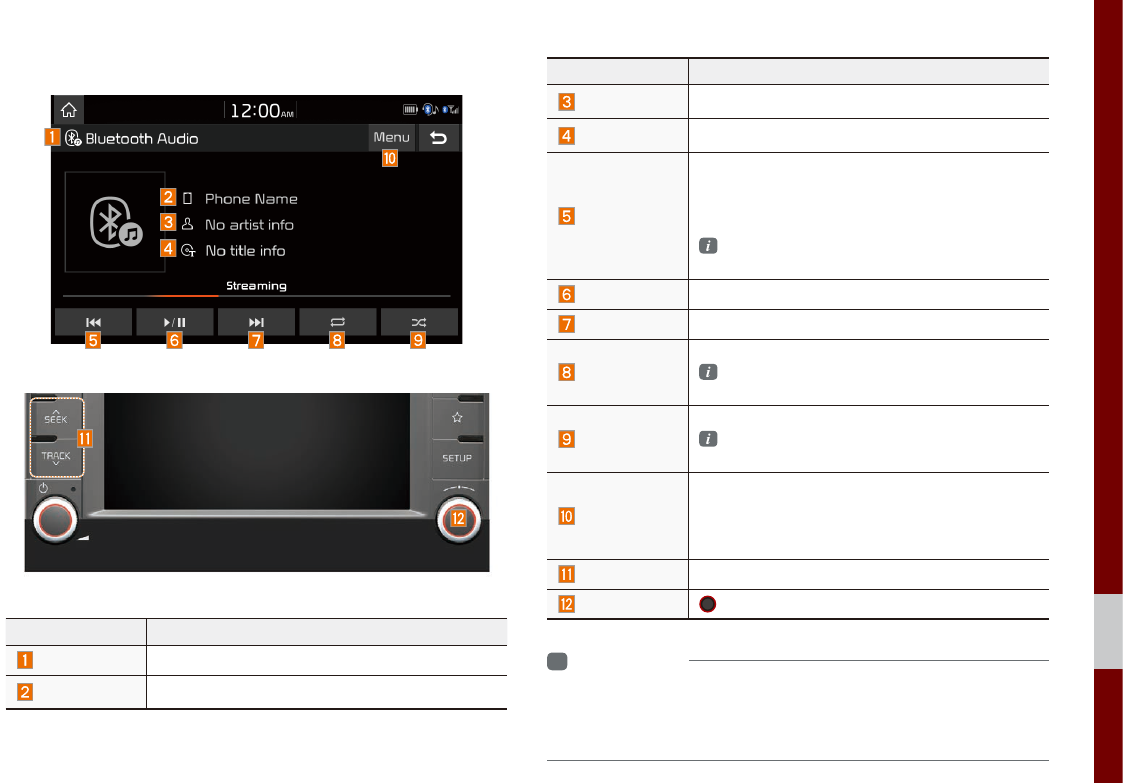
Bluetooth® Audio I 2-19
02
Bluetooth
®
Audio
Features Description
Mode Displays current operating mode
Phone Name Displays name of connected phone
Features Description
Artist Info Name of current artist
Title Name of current song
Previous File
• If play time is less than 3 seconds, moves to
the previous file
• If play time is over 3 seconds, plays the cur-
rent file from the beginning
This function may differ depending on the
model of mobile phone
Play/Pause Plays/Pauses Bluetooth Audio
Next File Moves to the next file
Repeat
Repeats the current file.
This function may differ depending on the
model of mobile phone.
Shuffle
Plays files in random order.
This function may differ depending on the
model of mobile phone.
Menu
• Connection settings: moves to the Bluetooth
Settings. You can pair a new device or change/
delete paired device(s).
• Sound settings: moves to the sound settings.
SEEK/TRACK
Plays the previous/next file
TUNE TUNE is not supported.
i
Information
• Artist info and Title may not be supported by mobile phone.
• While in use of other functions after connecting your mobile phone
through a USB cable, the Bluetooth audio is disabled.
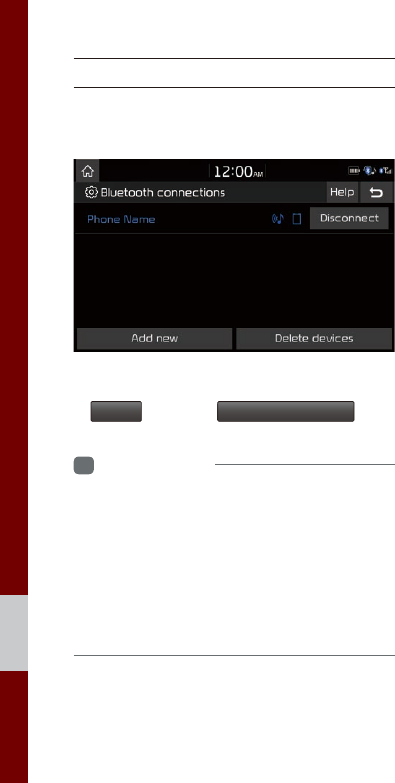
2-20 I Radio/Media
Bluetooth connections
Settings for pairing, connection and dis-
connection of a Bluetooth device.
• In Bluetooth Audio play screen, select
Menu
and then
Connection settings
.
i
Information
• If the music in the mobile phone is not played
after changing to audio streaming mode,
press the play button. Thus check if the
music is playing in the Bluetooth device after
changing to audio streaming mode. Audio
streaming may not be supported for some
mobile phones.

3-2 I Bluetooth
Before Using the
Bluetooth
®
Handsfree
What is
Bluetooth
®
Wireless Technology?
•
Bluetooth
® Wireless Technology refers
to a short-distance wireless networking
technology which uses a 2.45GHz fre-
quency to connect various devices within
a certain distance.
• Supported within PCs, external devices,
Bluetooth® phones, PDAs, various elec-
tronic devices, and automotive environ-
ments,
Bluetooth
® Wireless Technology
to be transmitted at high speeds without
having to use a connector cable.
• Bluetooth® Handsfree refers to a device
which allows the user to conveniently
make phone calls with Bluetooth®
mobile phones through the Multimedia
system.
• The Bluetooth® Handsfree feature
may not be supported in some mobile
phones.
Precautions for Safe Driving
• Bluetooth® is a feature that enables driv-
ers to practice safe driving. Connecting
the head unit with a Bluetooth® phone
allows the user to conveniently make
calls, receive calls, and manage the
phonebook. Before using
Bluetooth
®
Wireless Technology, carefully read the
contents of this user’s manual.
• Excessive use or operations while driv-
ing may lead to negligent driving prac-
tices and be the cause of accidents. Do
not operate the device excessively while
driving.
• Viewing the screen for prolonged peri-
ods of time is dangerous and may lead
to accidents. When driving, view the
screen only for short periods of time.
Bluetooth

Before Using the Bluetooth
®
Handsfree I 3-3
03
CAUTIONS upon Connecting
Bluetooth® Phone
• Before connecting the head unit with the
mobile phone, check to see that the mobile
phone supports Bluetooth® features.
• Even if the phone supports
Bluetooth
®
Wireless Technology, the phone will
not be found during device searches if
the phone has been set to hidden state
or the Bluetooth® power is turned off.
Disable the hidden state or turn on the
Bluetooth® power prior to searching/
connecting with the head unit.
• If Auto Connection is used, the Bluetooth®
phone is automatically connected when
the ignition is turned on, making it unnec-
essary to have to connect the phone with
the head unit every time.
• If you do not want automatic connection
with your Bluetooth® device, turn the
Bluetooth® feature off of the Bluetooth®
device.
• Park the vehicle when connecting the
head unit with the mobile phone.
• Bluetooth® connection may become
intermittently disconnected in some
mobile phones. Follow these steps to try
again.
1. Turn the Bluetooth® function within the
mobile phone OFF/ON and try again.
2. Turn the mobile phone power OFF/
ON and try again.
3. Completely remove the mobile phone
battery, reboot, and then again.
4. Reboot the Multimedia System and
try again.
5. Delete all paired devices from both of
Phone and Head Unit sides and then
try again.
• The Handsfree call volume and quality
may differ depending on the mobile
phone.
• Pairing Bluetooth® devices and use of
other Bluetooth® features are not sup-
ported when the vehicle is in motion. For
safety, please first park your vehicle.
• If you continue having issues with
downloading contacts, please check the
mobile phone status or inquire of the
mobile phone manufacturer.
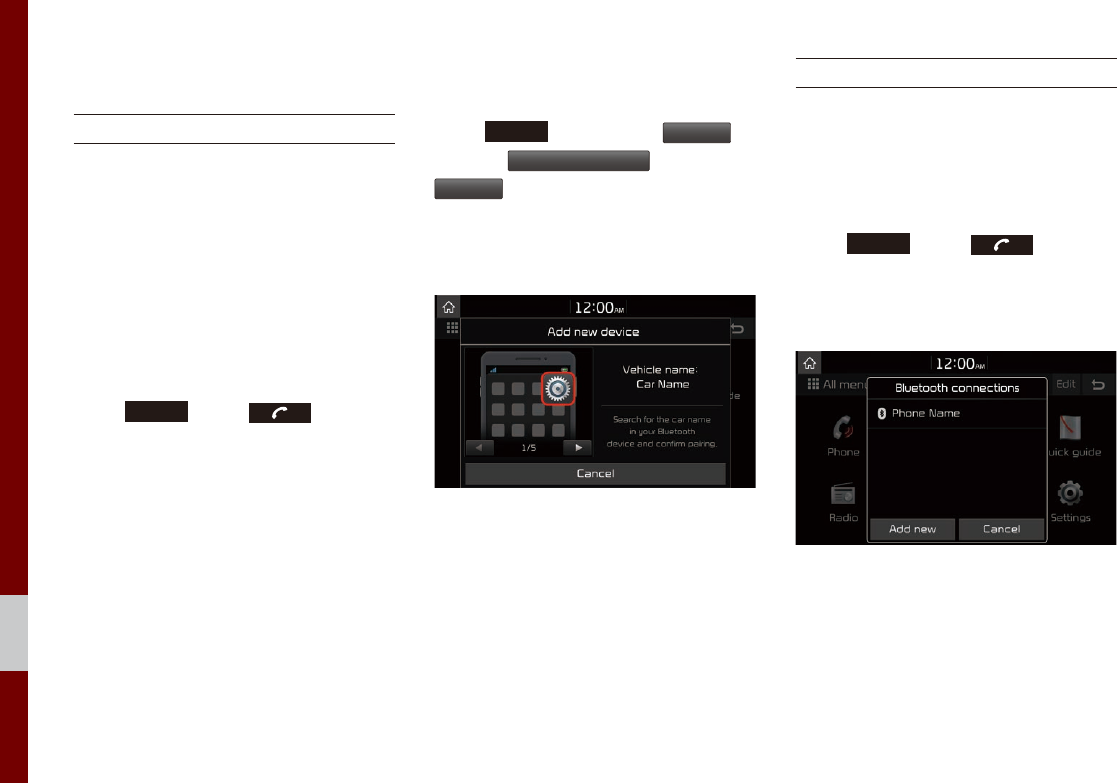
3-4 I Bluetooth
Bluetooth Connection
Pairing a New Device
Before you can use the Bluetooth feature,
you must first pair/connect your mobile
phone to your car.
Up to 5 Bluetooth devices can be paired.
Only one Bluetooth device can be con-
nected at a time.
Pairing a New Device by Selecting
Phone/Call
Press
PHONE
key or key in the
steering wheel control. ▶ Pair your car
after your mobile phone detects the
Bluetooth device. ▶ Enter the passkey or
accept the authorisation popup. ▶
Connect Bluetooth.
Pairing a New Device Through the
Phone Settings
Press
SETUP
key. ▶ Select
Bluetooth
. ▶
Select
Bluetooth connections
. ▶ Select
Add new
. ▶ Pair your car after your mobile
phone detects the Bluetooth device. ▶
Enter the passkey or accept the authorisa-
tion popup. ▶ Connect Bluetooth.
The default passkey is 0000.
The vehicle name above is an example.
Check the actual information on the product.
Connecting Bluetooth Devices
Connects the Bluetooth devices that you
add.
Connecting Devices by Selecting
Phone/Call
Press
PHONE
key or key in the
steering wheel control. ▶ Select the name
of the device to connect. ▶ Connect
Bluetooth.
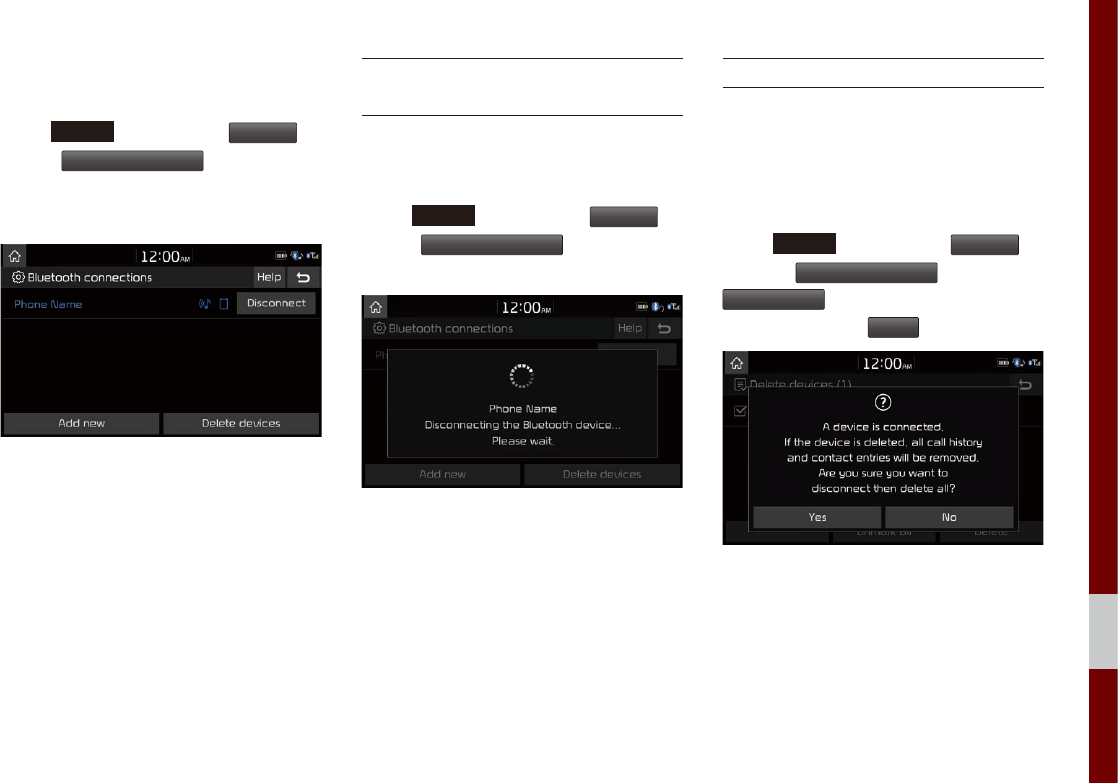
Bluetooth Connection I 3-5
03
Connecting Devices Through the
Phone Settings
Press
SETUP
key. ▶ Select
Bluetooth
. ▶
Select
Bluetooth connections
. ▶ Select the
name of the device to connect. ▶ Connect
Bluetooth.
Disconnecting
Bluetooth Devices
Disconnects Bluetooth devices that are
connected.
Press
SETUP
key. ▶ Select
Bluetooth
. ▶
Select
Bluetooth connections
. ▶ Select the
name of the device to disconnect.
Deleting Bluetooth Devices
Deletes the Bluetooth devices that you
added. Note that deleting a Bluetooth
device will delete all Call History and
Contact Info downloaded along with it.
Press
SETUP
key. ▶ Select
Bluetooth
. ▶
Select
Bluetooth connections
. ▶ Select
Delete devices
. ▶ Select the device name
to delete. ▶ Select
Delete
.
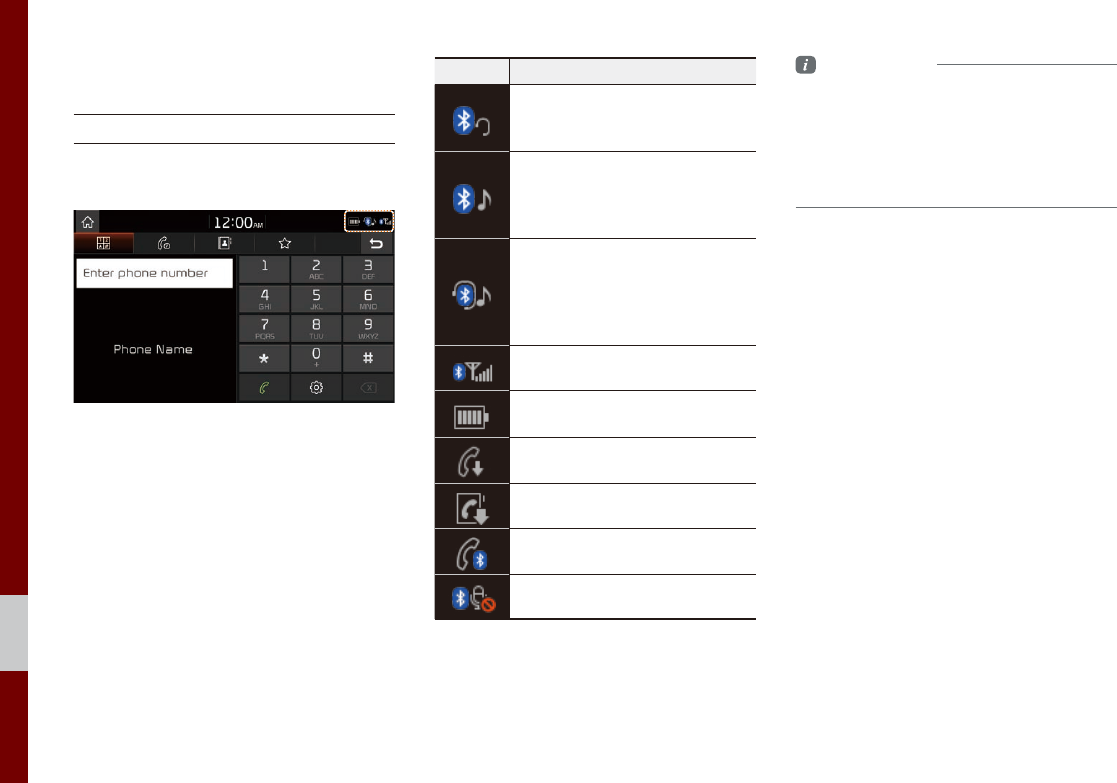
3-6 I Bluetooth
Bluetooth Phone
Phone Status Icons
Shows the current phone status in the
right top of the display.
Icons Description
You can use Bluetooth phones
when a Bluetooth Hands-free
connection is established.
You can use Bluetooth audio
features when a Bluetooth
audio connection is estab-
lished.
You can use Bluetooth phones
and audio features when both
Bluetooth Hands-free and
audio connections are estab-
lished.
Call signal strength indicator
Battery level of the Bluetooth
devices connected
Downloading Call History list
Downloading Contacts
In a Bluetooth phone call
Microphone muted
Information
• The battery level icon and the call signal
strength indicator may not be supported in
some Bluetooth devices.
• The battery level may differ from the actual
level remaining.
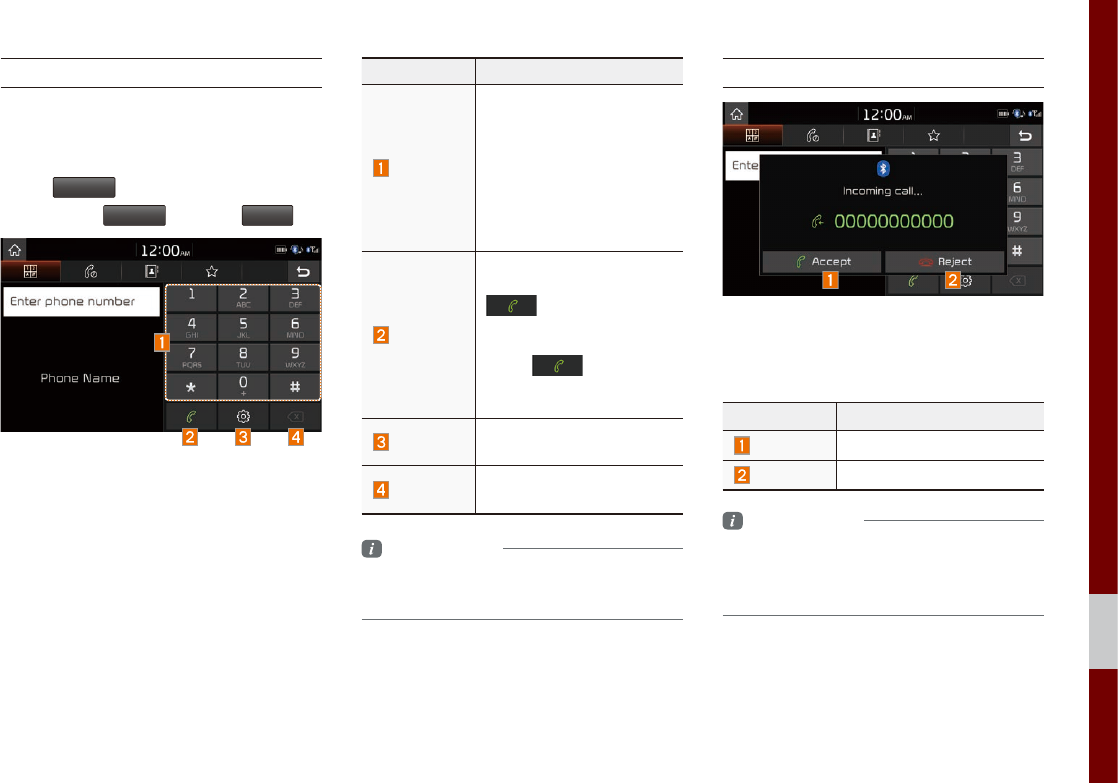
Bluetooth Phone I 3-7
03
Dial
Dials a call after the Bluetooth devices
are connected.
Select
All menus
from the Home screen dis-
play ▶Select
Phone
▶ Select
Dial
.
Name Description
Keypad
Use the keypad to enter
the phone number that
you want to call. Select
and hold the last number
of a speed dial to dial a
number that you added to
the Speed Dial list in the
phone.
Call
Makes a call after you dial
a number and select
. If the number is
listed in Dialled Calls, you
can select the number and
select to automati-
cally dial that number
again.
Settings Moves to a screen of
Bluetooth Settings.
Delete Deletes the numbers that
you entered.
Information
• Some types of mobile phones may not
support the Speed Dial function.
Accept/Reject Call
If there is an incoming call after you made
a Bluetooth connection, a popup message
will appear.
Name Description
Accept Answers the call.
Reject Ignores the call.
Information
• In some mobile phones, the caller's number
may not be displayed, and the Reject
feature may not be supported.
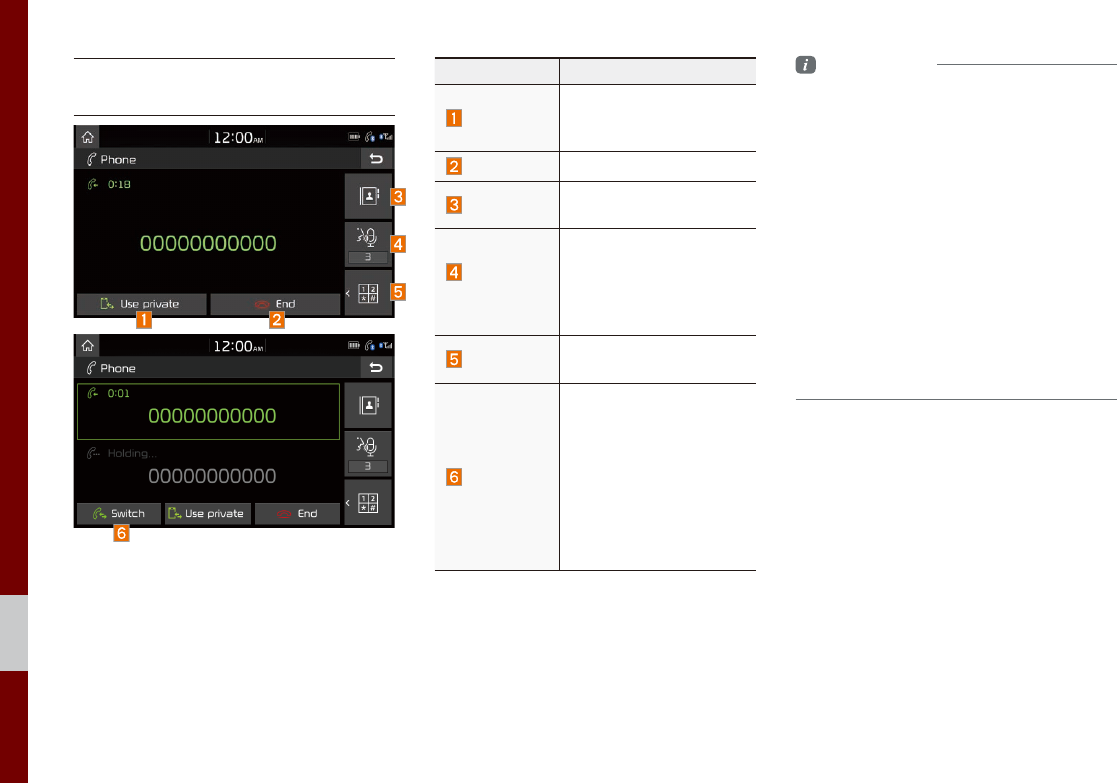
3-8 I Bluetooth
Using the Menu During
a Phone Call
When making a call, you can use the fol-
lowing menu items.
Name Description
Use private
Switches a voice call
from the car Hands-free
to the mobile phone.
End Ends a call.
Contacts Displays the Contacts
list.
Outgoing
Volume
Displays the Mic Volume
settings. You can adjust
the in-call volume that
the other party hears
(level 1 to 5).
Keypad Moves to a screen for
entering ARS numbers.
Switch
Switches to a call on
hold, if any. You can also
switch calls by select-
ing the number in the
Information Display. The
Switch function switches
the current call to a wait-
ing call in order to answer
a new incoming call.
Information
• If the caller's number is listed in Contacts, the
caller's name will be displayed. Otherwise,
only the number will be displayed. In some
mobile phones, the phone number may not
be displayed.
• In some Bluetooth devices, the Use Private
feature may not be supported.
• In some Bluetooth devices, the Switch feature
may not be supported.
• Depending on handset types, the in-call
volume the other party hears may differ. If the
other party hears your voice too low or too
loud, adjust the mic volume.
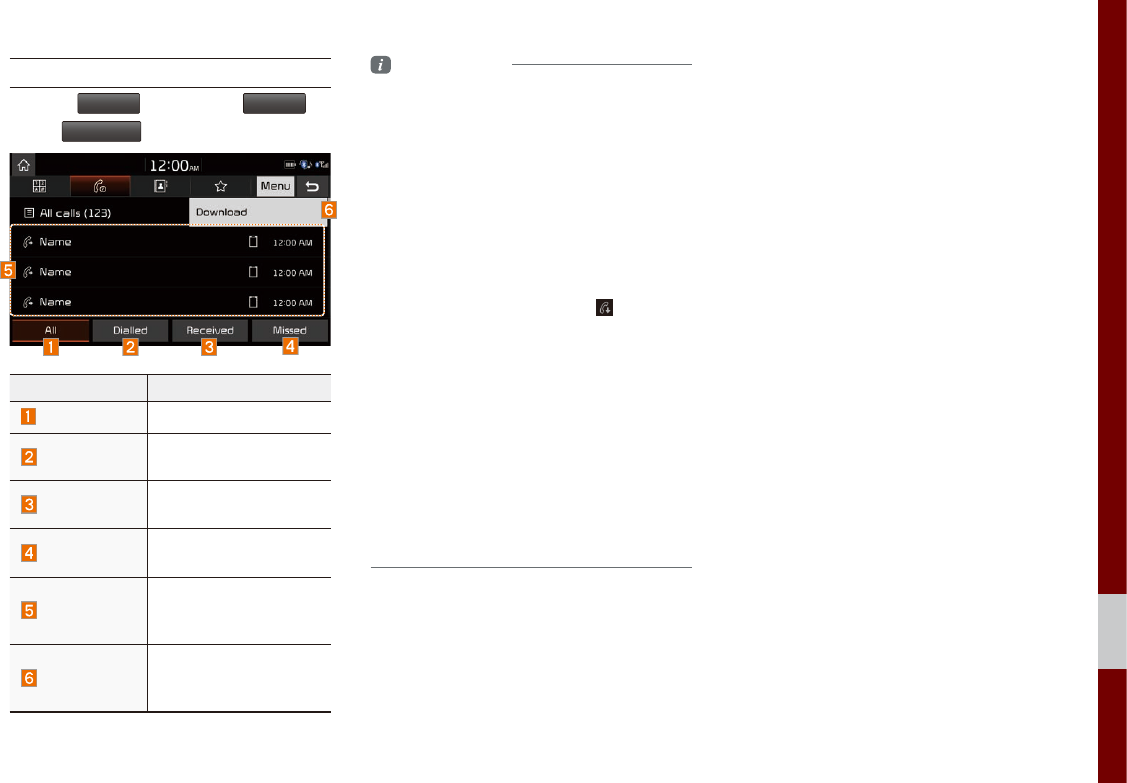
Bluetooth Phone I 3-9
03
Call History
Select
All menus
▶ Select
Phone
▶
Select
Call History
.
Name Description
All Lists the all call history.
Dialled Lists the calls that you
made.
Received Lists the calls that you
have received.
Missed Lists the calls you
missed.
Call History
Displays all of your call
history. Select from the
list to dial the number.
Download
Downloads the call his-
tory information from
your mobile phone.
Information
• In some mobile phones, call records may not
be added to your Call History.
• Calls from restricted ID's are not added to
your Call History Information.
• Up to 50 calls can be added in each Dialled
Calls/Received Calls/Missed Calls list.
• The durations of each dialled/received call are
not displayed in your car's Call History list.
• While the call history download is in progress,
the status bar displays an icon ( ).
• If the call history download is turned off on the
Bluetooth device, the call history download
will fail.
• Some devices require a device authentication
for downloading your call history. If download
fails, check if the Bluetooth settings or display
status are normal.
• Some devices do not support call history
download. Check if your Bluetooth device
supports download feature.
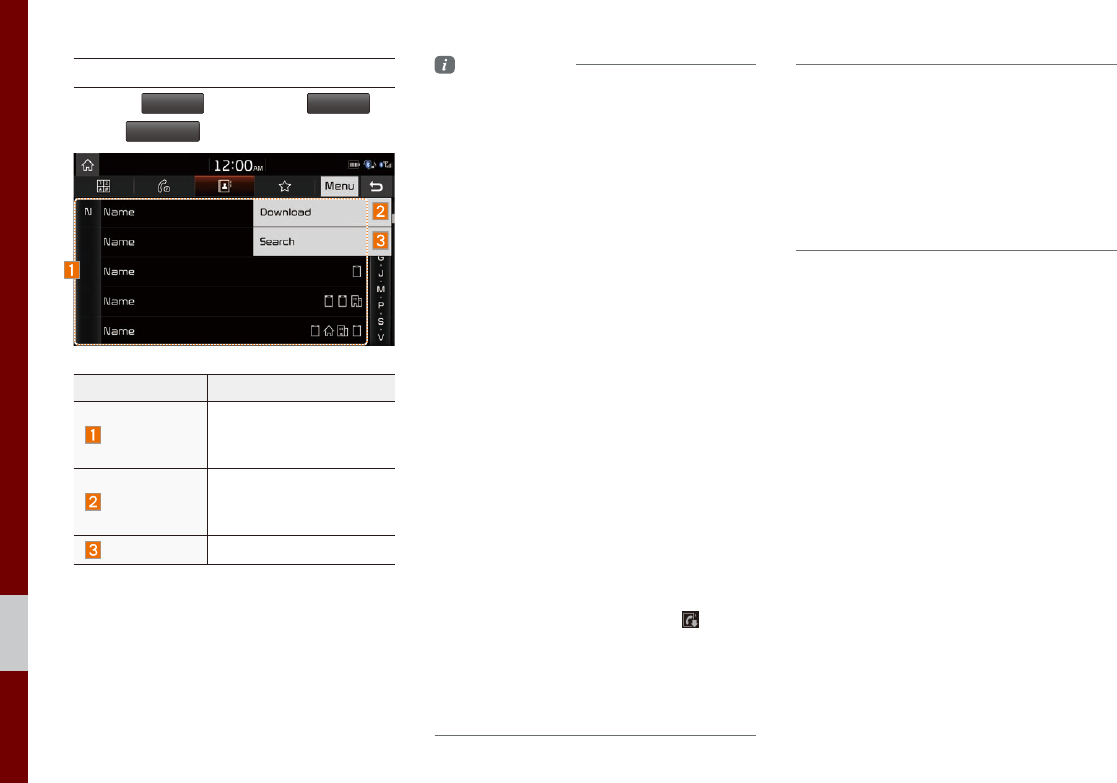
3-10 I Bluetooth
Contacts
Select
All menus
▶ Select
Phone
▶
Select
Contacts
.
Name Description
Contacts List
The list of Contacts.
Select from the list to
dial the number.
Download
Downloads contacts
from your mobile
phone.
Search Searches Contacts.
Information
• Up to 5000 phone numbers can be
downloaded from a single, paired Bluetooth
device.
• You cannot edit or delete downloaded phone
numbers from your car.
• Contacts can be viewed only when the
Bluetooth device is connected.
• Even if the Bluetooth device is disconnected,
the downloaded data will remain. (Note that
deleting a paired phone will also delete all
downloaded Contacts and Call History data)
• Downloaded phone numbers may be lost
depending on the condition of the Multimedia
system. Keep your important data in a safe
place.
• Contacts from both the SIM card and your
mobile phone are downloaded at the same
time by default.
• Only supported contacts format can be
downloaded and displayed from the Bluetooth
device, contacts from some applications will
not be included.
• The status bar displays a ( ) while
downloading contacts.
• The download will not be available if the
contacts download function is turned off on
your Bluetooth device.
• Some devices require a device authentication
for downloading your contacts. If download
fails, check your phone screen and confirm
the download if necessary.
• Some devices do not support contacts
download feature. Check if your Bluetooth
device supports contacts download.
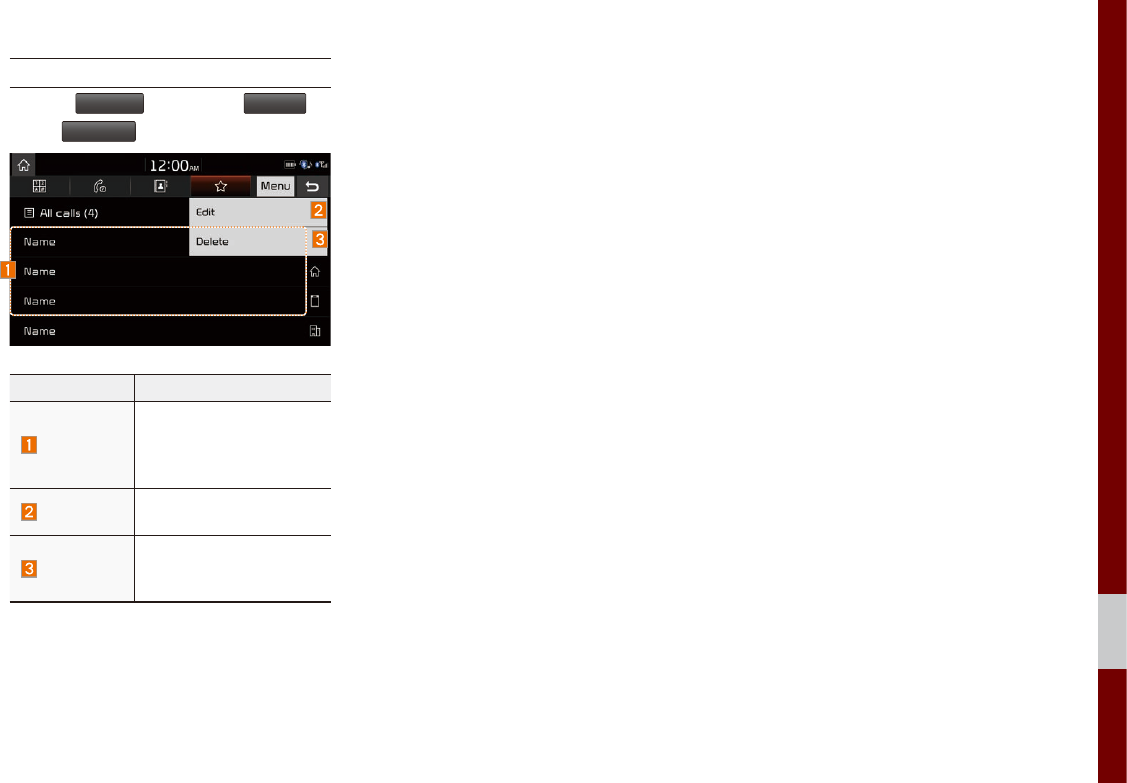
Bluetooth Phone I 3-11
03
Favourites
Select
All menus
▶ Select
Phone
▶
Select
Favourites
.
Name Description
Favourites
Lists the phone numbers
saved as Favourites.
Select from the list to dial
the number.
Edit Add or delete numbers
from favorites.
Delete
Deletes numbers
that you select from
Favourites.

MEMO

Camera
part.4 Other Features
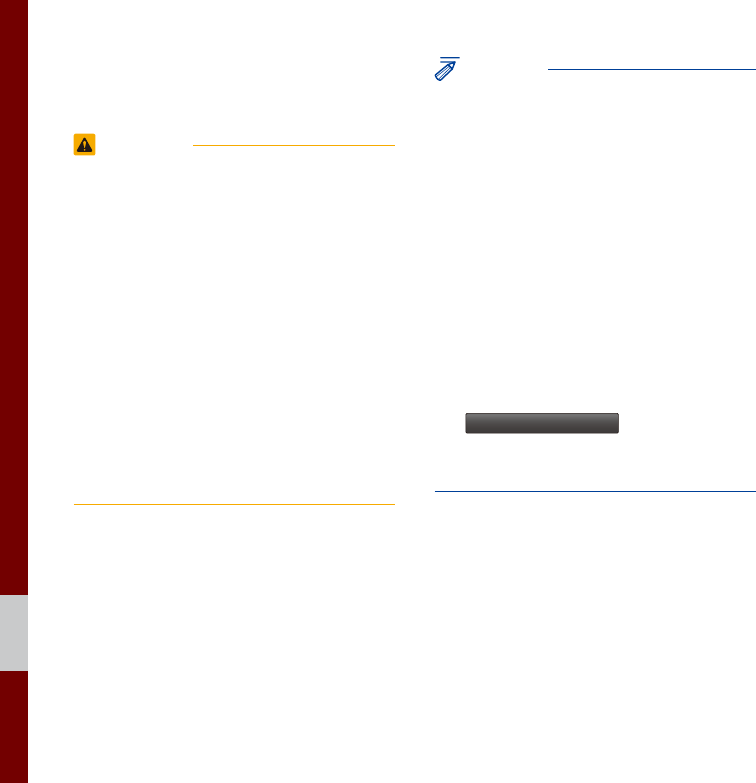
4-2 I Other Features
Camera
WARNING
- Backing Up & Using Camera
• Never rely solely on the rear view camera
when backing up. Prior to entering your
vehicle always do a visual check of the
area behind your vehicle, and before
backing up be aware of your surroundings
and supplement the rear view camera by
looking over your shoulders and checking
your rear view mirrors. Due to the difficulty
of ensuring that the area behind you
remains clear, always back up slowly and
stop immediately if you even suspect that
a person, and especially a child, might be
behind you.
NOTICE
• The camera screen shown while the
system boots up does not display any text
or buttons.
• A wide-angle lens is installed as the rear
detection camera to get a wider view, so
there may be some difference between
the actual distance and the distance that
appears. on-screen. For safety, make sure
to view the back, right, and left sides of the
car for yourself.
• The color of the parking guidelines
displayed in the picture may differ from the
actual screen.
• When booted up, blinking may occur when
you switch to a UI screen.
• If
Back-up warning priority
is set in the Sound
Settings, the audio volume is lowered when
your car is driving backward.
Other Features
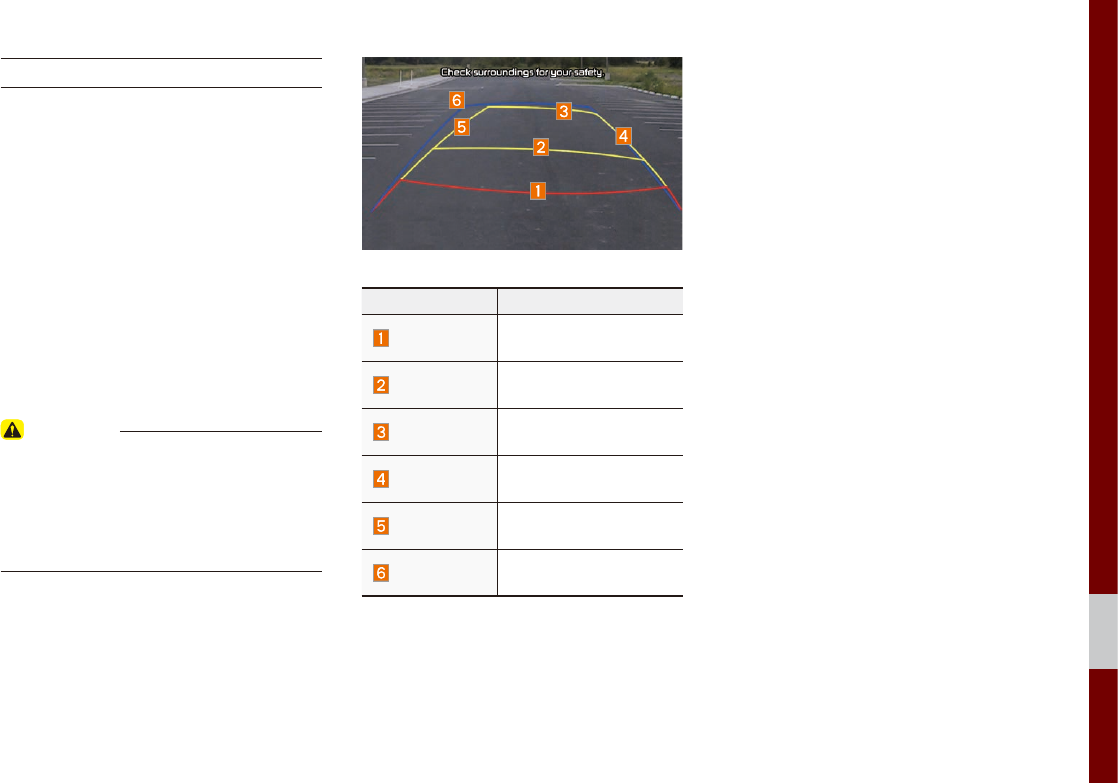
Camera I 4-3
04
Steering-linked camera
• This device is connected to a rear
detection camera to see behind the car
for safe reversing.
• The Rear View Camera turns on auto-
matically if you shift the gear to R when
the power is on or the engine has
started.
• While the device boots up, shift the gear to
"R" to activate the rear detection cameras.
Shift the gear to another position to deactivate
the rear detection camera.
CAUTION
• Because the cameras use wide-angle lenses
to provide a wide view, the distance in the
view may appear different to the actual
distance. Always check the left and right views
for safety.
Name Description
Red Line About 0.5 m from the
rear bumper
Yellow Line 1 About 1 m from the
rear bumper
Yellow Line 2 About 3 m from the
rear bumper
Yellow Line 3 Trajectory of the wheel
on the driver’s side
Yellow Line 4 Trajectory of the wheel
on the passenger side
Blue Line Neutral steering trajec-
tory
As you reverse your car and monitor the
area behind your car, the steering-linked
driving trajectory and the neutral driving
trajectory are both displayed.

MEMO

Settings
Sound settings
Display settings
Bluetooth settings
Phone projection settings
Custom button settings
Home screen settings
Date/Time settings
Language settings
Keyboard settings
Screensaver settings
Advanced settings
System info
part.5 Settings
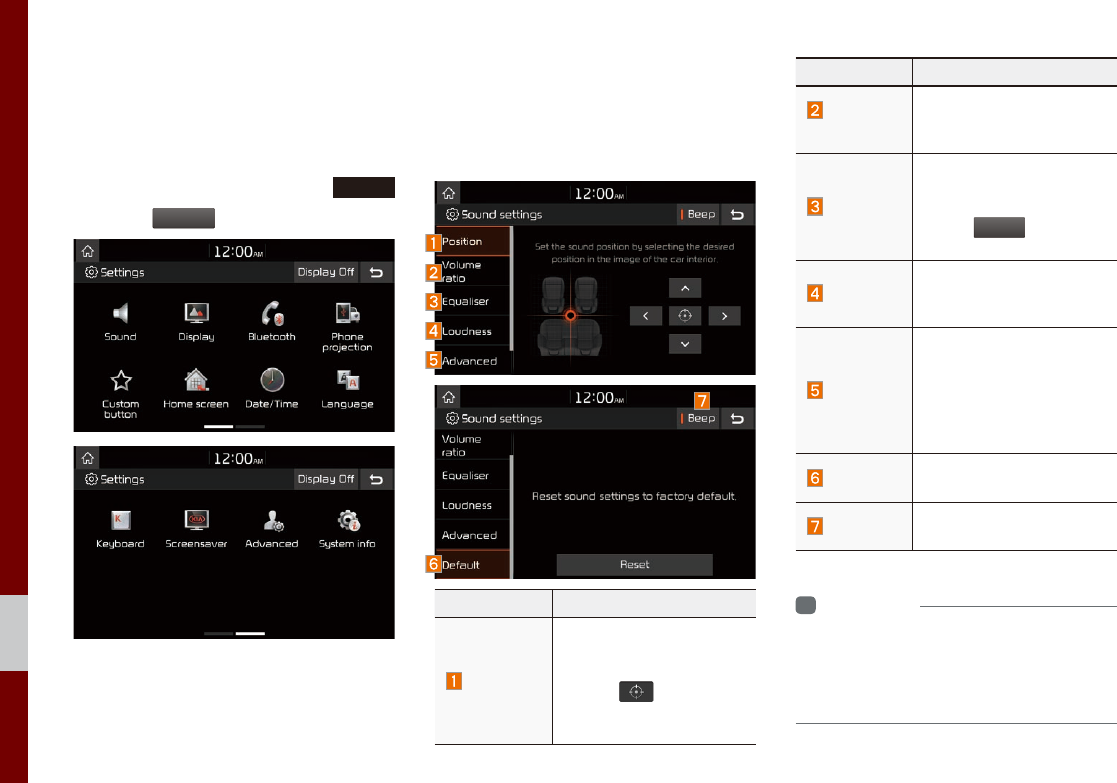
5-2 I Settings
Settings
Settings
Settings is the screen to control
Multimedia system settings.
To enter the screen, press the
SETUP
key or the
Settings
icon in All menus.
Sound settings
Adjusts the sound effects for the whole
system.
Features Description
Position
Select the Up/Down/Left/
Right button to control
sound positioning.
Select to concen-
trate the sound on the
centre of vehicle.
Features Description
Volume
ratio
Sets the volume of broad-
cast, media, ringtone, etc.,
respectively.
Equaliser
Drag the slide bar to con-
trol BASS/MID/TREBLE
settings.
Select
Centre
to initialise
the settings.
Loudness
Sets the volume ratio when
reversing the car, turning
on the car’s ignition, etc.
Advanced
Select additional audio
options such as “Speed
dependent volume control”
that automatically controls
Audio volume according to
vehicle speed.
Default Resets the sound to fac-
tory default settings.
Beep Select to activate a beep
when pressing buttons.
i
Information
• Advanced sound settings may differ according
to selected AMP option.
• The seat shape may differ according to
vehicle model.
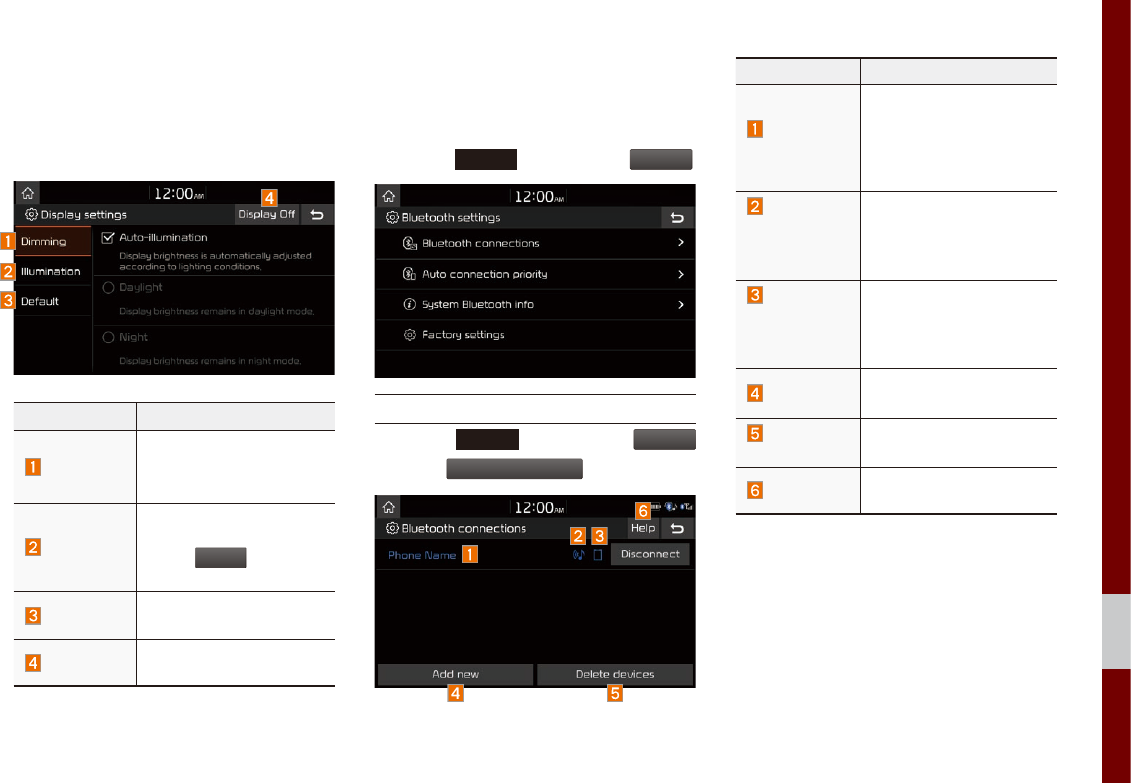
Display settings I 5-3
05
Display settings
Adjusts the level of illumination for the
entire system.
Features Description
Dimming
Sets the display bright-
ness according to mode
changes.
Illumination
Set the levels of illumina-
tion for day and night.
Select
Reset
to initialise
the settings.
Default Resets the display to fac-
tory default settings
Display Off Provides the Display Off
(touch activation) function.
Bluetooth settings
Changes Bluetooth phone settings.
Press the
SETUP
key ▶ Select
Bluetooth
.
Bluetooth connections
Press the
SETUP
key
▶
Select
Bluetooth
▶ Select
Bluetooth connections
.
Features Description
Paired
Device List
Displays the paired
Bluetooth device list.
When selecting from the
list, the device is con-
nected or disconnected.
Bluetooth
Audio
Connection
Status
An icon appears when
you make a Bluetooth
Audio connection.
Bluetooth
Hands-Free
Connection
Status
An icon appears when
you make a Bluetooth
Hands-free connection.
Add new
Register a new Bluetooth
device.
Delete
devices
Select and delete a paired
device.
Help Switches to the Bluetooth
Connection Help screen.
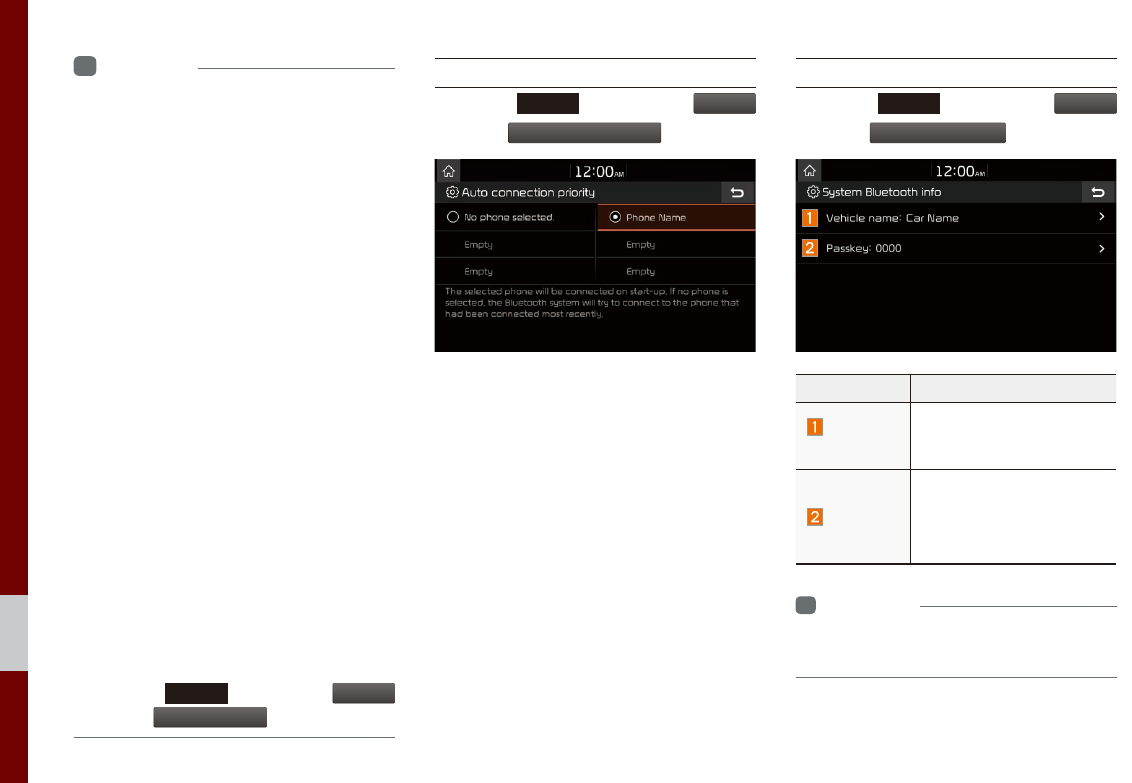
5-4 I Settings
i
Information
• Up to 5 Bluetooth devices can be paired.
• Only one Bluetooth device can be connected
at a time.
• During a Bluetooth device connection, another
device cannot be paired.
• When you delete a paired device, the Call
History and Contacts stored in the head unit
are also deleted.
• Bluetooth Hands-free and Bluetooth Audio
functions are supported.
• Hands-free and audio-supported devices,
such as a Bluetooth smartphone or audio,
will function normally.
• When a Bluetooth device is connected, if
the Bluetooth connection is unexpectedly
disconnected, due to being out of
communication range, the device powering
off, or a Bluetooth communication error, the
Bluetooth device automatically searches for
and connects to nearby Bluetooth devices.
• If the system is not stable, due to a
vehicle-Bluetooth device communication
error, restore the Factory settings.
• For Factory settings, the Bluetooth settings
are reset to factory settings.
• Press the
SETUP
key ▶ Select
Bluetooth
▶ Select
Factory settings
.
Auto connection priority
Press the
SETUP
key
▶
Select
Bluetooth
▶
Select
Auto connection priority
.
When the engine is running, the selected
Bluetooth device is automatically con-
nected. If you fail to connect the selected
device, the previously-connected device is
automatically connected, and if it also fails,
then it tries to connect all paired devices
sequentially.
Depending on auto connection priority,
connection to a device may take time.
System Bluetooth info
Press the
SETUP
key
▶
Select
Bluetooth
▶ Select
System Bluetooth info
.
Features Description
Vehicle
name
You can change the
Bluetooth device name of
the vehicle.
Passkey
You can change the pass-
key used for Bluetooth
device authentication. The
initial passkey is 0000.
i
Information
• The vehicle name above is an example.
Check the actual information on the product.
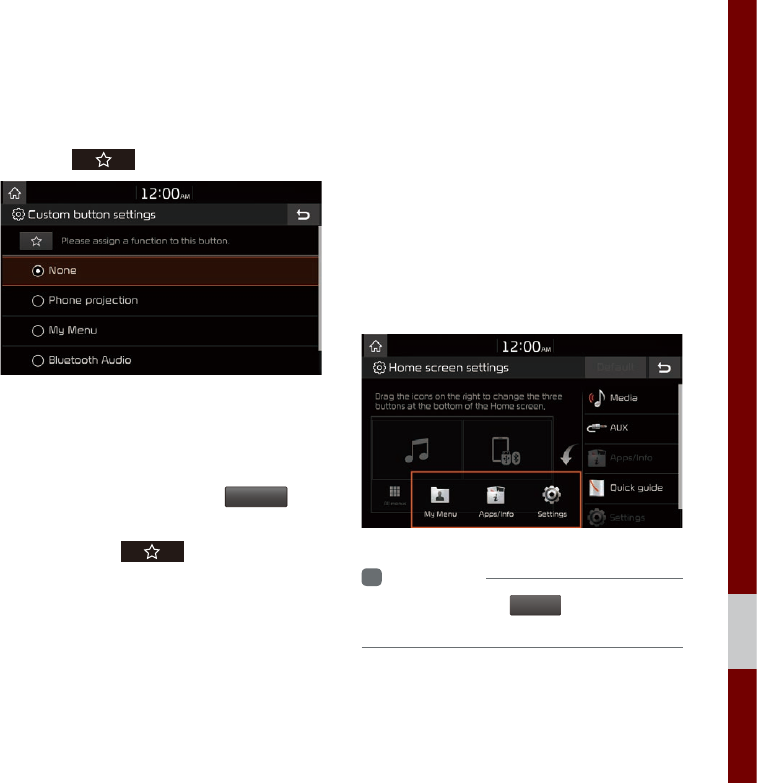
Phone projection settings I 5-5
05
Phone projection
settings
For more details, refer to the Phone pro-
jection guide.
Custom button settings
You can choose the feature to be accessed
when the key is pressed.
Setting it to a feature that you frequently
use will allow you to access the feature
quickly and conveniently anytime.
For example, setting it to
My Menu
will
enable you to access the My Menu screen
by pressing the key.
Home screen settings
You can customise the three menu items
at the bottom right of the Home Screen
into the ones you want.
On the Home Screen Settings screen,
drag the menu items on the right to the
area marked in red in the screen below.
i
Information
• You can select the
Default
button to reset to
the factory default settings.
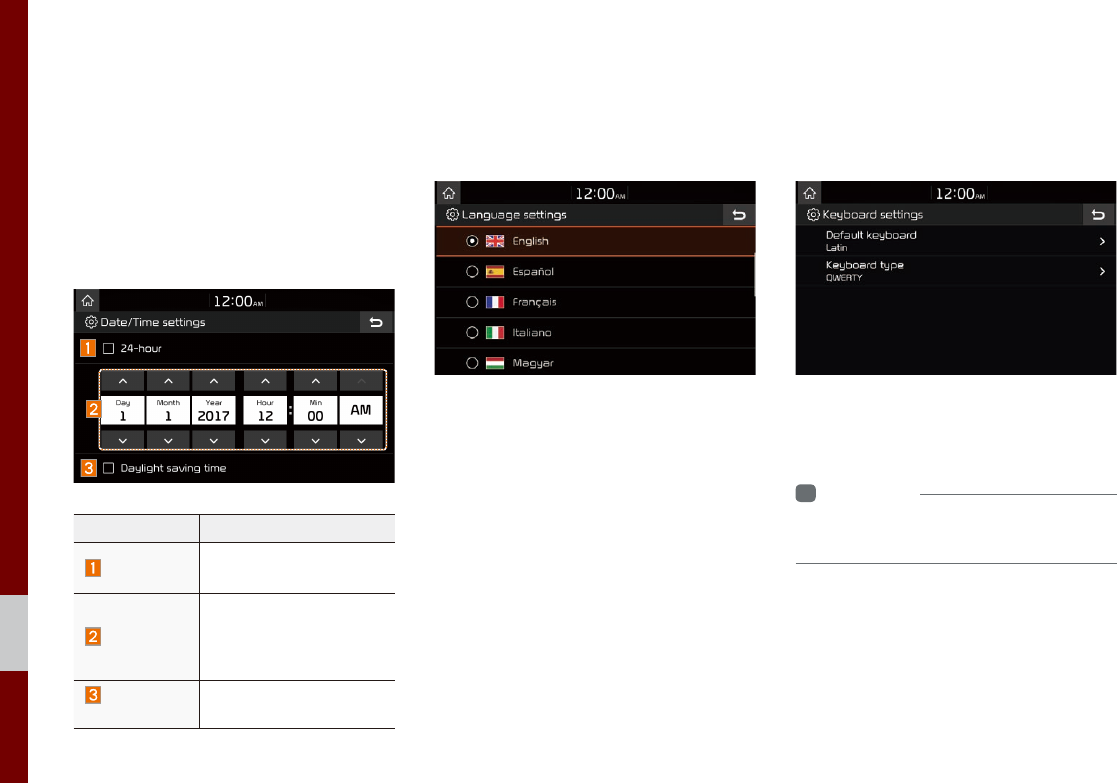
5-6 I Settings
Date/Time settings
Configure the settings for time and date.
Using the arrow buttons, you can change
the values. Date/Time settings do not
automatically change when crossing into
different time zones. The time must be
changed manually on this screen.
Features Description
24-hour The time display is set in
24-hour format.
Direct entry
If you tap any value, you
can directly enter the
number in the following
screen.
Daylight
saving time
The daylight saving time
(DST) is applied.
Language settings
You can configure the displayed system
language.
When the language is changed, the sys-
tem language is automatically changed.
Unique data including MP3 file name is
not changed.
Keyboard settings
You can configure the keyboard layout for
each language.
You can configure ABCD or QWERTY
keyboards for the system.
i
Information
• Configured keyboard layouts are applied
to all input modes.
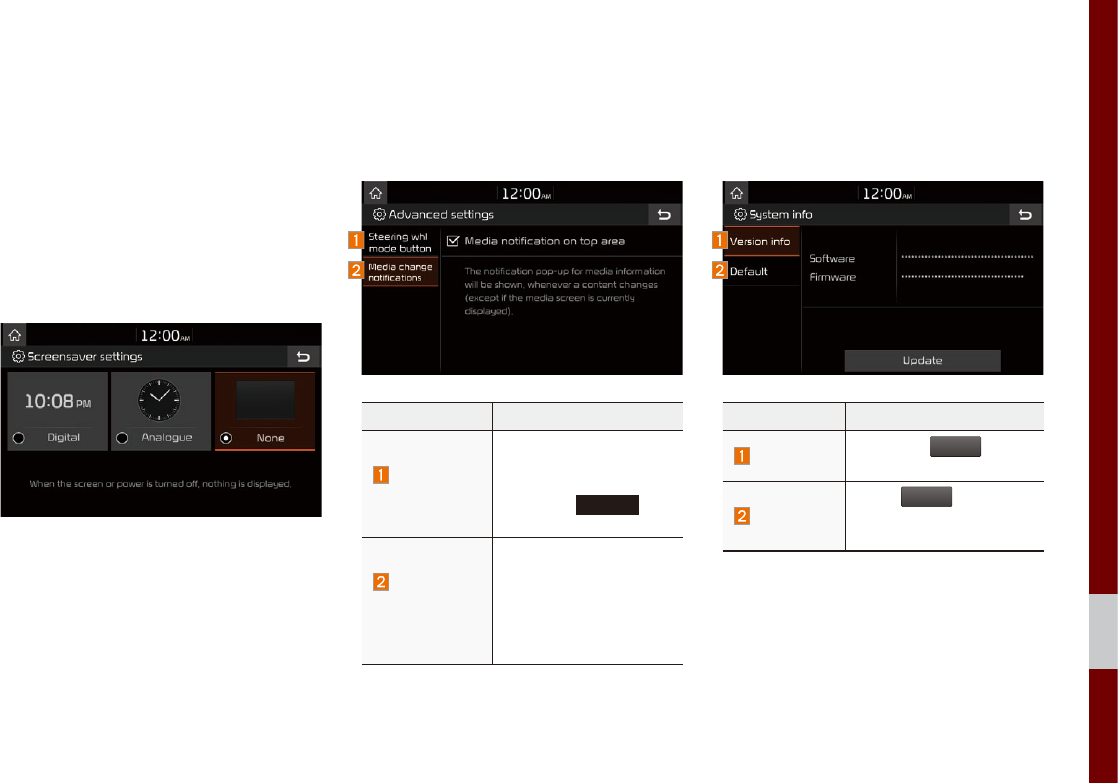
Screensaver settings I 5-7
05
Screensaver settings
You can select any of the following screen
formats to be displayed when the screen
or power is turned off (press and hold the
Power button).
• Digital clock and date
• Analogue clock and date
• None
Advanced settings
Sets alerts per function if desired by the
user.
Features Description
Steering whl
mode button
Sets the media to be
played when the steer-
ing wheel or rear seat (if
provided)
MODE
but-
ton is pressed.
Media
change
notifications
Sets whether to display
media information at
the top of the screen as
the next item is played
when not on the media
screen.
System info
System version information and update
details are available.
Features Description
Version info Select the
Update
button
to update the system.
Default
When
Default
is selected,
the settings are changed
to factory defaults.

5-8 I Settings
System Update
At the System Info screen, insert the USB
memory with the latest file downloaded,
and then select the
Update
button to begin
updating. The system will then reboot
automatically.
i
Information
• This product needs supplemented software
updates and additional functions, which
collectively may take some time to complete,
depending on the amount of data.
NOTICE
• If the power is disconnected or the USB is
removed during an update, the data might be
damaged. Please do not turn off the vehicle
while an update is in progress.
• When
Default
is selected, it may delete all of
the data and settings so be cautious of your
action.
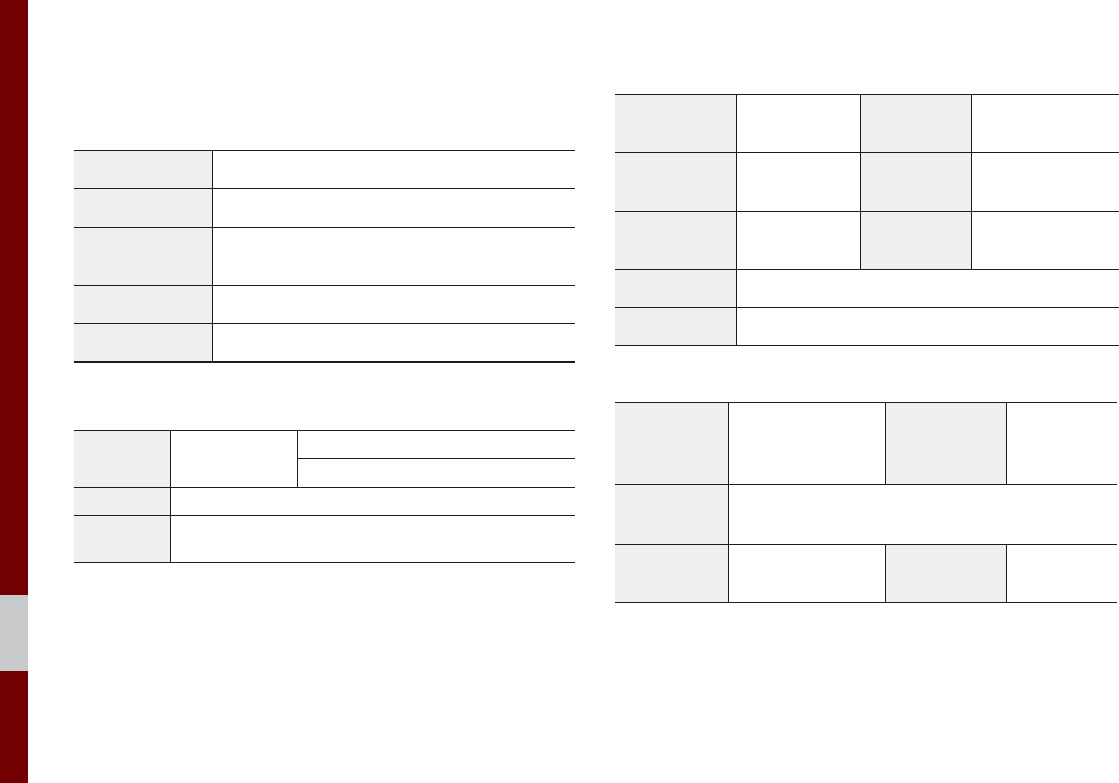
6-2 I Appendix
Product Specification
TFT-LCD
Screen Size 7 inch(152.4 X 91.44 mm)
Resolution 384,000 pixels (Resolution: 800 x 480)
Operating
Method TFT(Thin Film Transistor) Active Matrix
Viewing Angle Left/Right, Top/Bottom: ALL 89°
Internal Lighting LED
Radio
Channels Country3(A3) FM : 87.50 to 108.00 MHz (Step: 50 kHz)
AM : 522 to 1620 kHz (Step: 9 kHz)
Sensitivity FM: Under 10dBuV/AM: Under 35dBu EMF
Distortion
Factor Within 2 %
Common
Power Supply DC 14.4 V Operating
Power DC 9 V to DC 16 V
Current
Consumption 2.5 A Sleep
Current
1 mA
(Head Unit Only)
Operating
Temperature
-20 to +70 °C
(-4 to +158 °F)
Storage
Temperature
-40 to +85 °C
(-104 to +185 °F)
Dimensions 234 X 147 X 201 mm
Weight 1.8 (DAB) / 1.7 kg
Bluetooth
® Wireless Technology
Frequency
Range 2402 to 2480 MHz
Supported
Bluetooth
®
Specification
3
Supported
Profile Handsfree(1.6), A2DP(1.2), AVRCP(1.4), PBAP(1.0)
Number of
Channels 79 channels Maximum
Output Power 0 dBm
Appendix
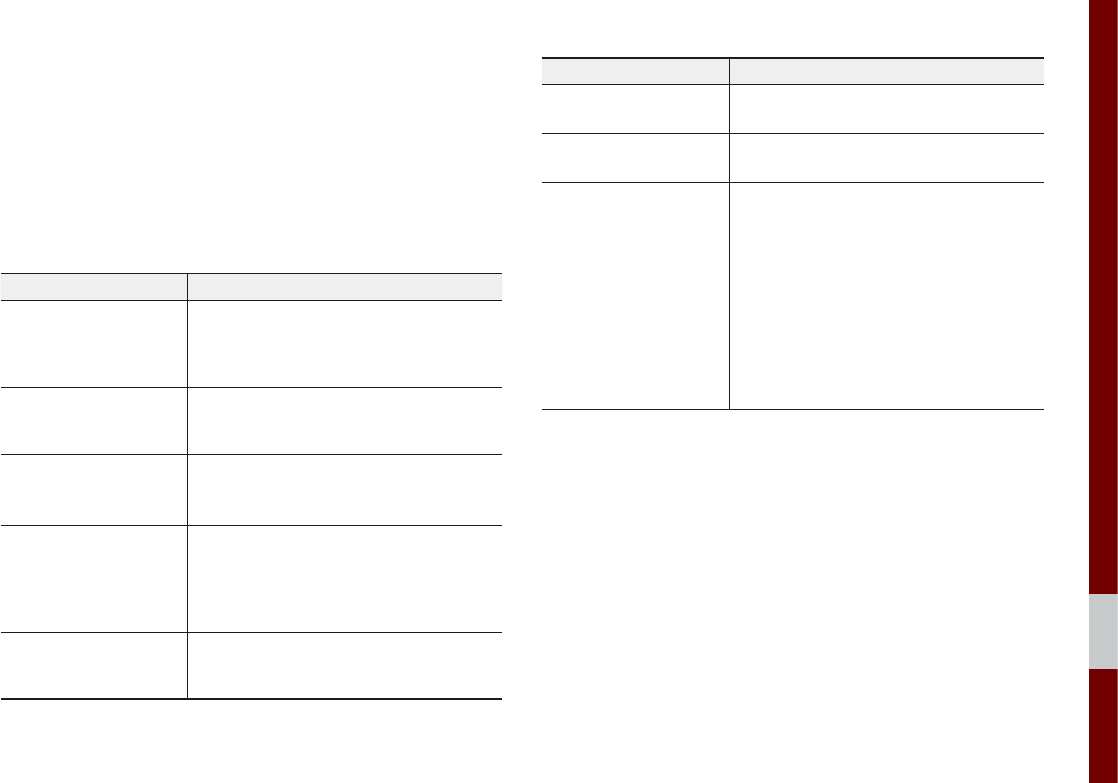
Troubleshooting I 6-3
06
Troubleshooting
1. Errors which occur during the operation or installation of the
device may be mistaken as a malfunction of the actual device.
2. If you are having problems with the device, try the suggestions
listed below.
3. If the problems persist, contact your Kia dealer.
Problem Possible Cause
There are small red,
blue, or green dots on
the screen
• Because the LCD is manufactured with
technology requiring high point density,
a pixel or lighting deficiency may occur
within 0.01% of total pixels
The sound or image is
not working
• Has the Switch for the vehicle been
turned to [ACC] or [ON]?
• Has the SYSTEM been turned OFF?
The screen is being
displayed but sound is
not working
• Has the volume been set to a low level?
• Has the volume been muted?
When the power is
turned on, the corners
of the screen are dark
• The display appearing somewhat dark
after prolonged periods of use is normal
with LCD panels. It is not a malfunction
• If the screen is very dark, contact your
nearest Kia dealer for assistance
Sound is working from
only one speaker
• Are the positions of Fader or Balance
sound controls adjusted to only one
side?
Problem Possible Cause
Sound does not work in
AUX mode
• Are the audio connector jacks fully
inserted into the AUX terminal?
The external device is
not working
• Is the external device connected with a
standard connector cable?
Upon turning power on,
the most recent mode
screen is not displayed
Within modes that play files by reading
external sources, such as USB, iPod, or
Bluetooth
®
streaming mode, the most
recently played mode screen prior to turn-
ing off power may not properly load.
• If the corresponding device is not con-
nected, the mode operated prior to the
most recent mode will operate
• If the previous mode still cannot be
properly played, the mode operated
prior to that will operate
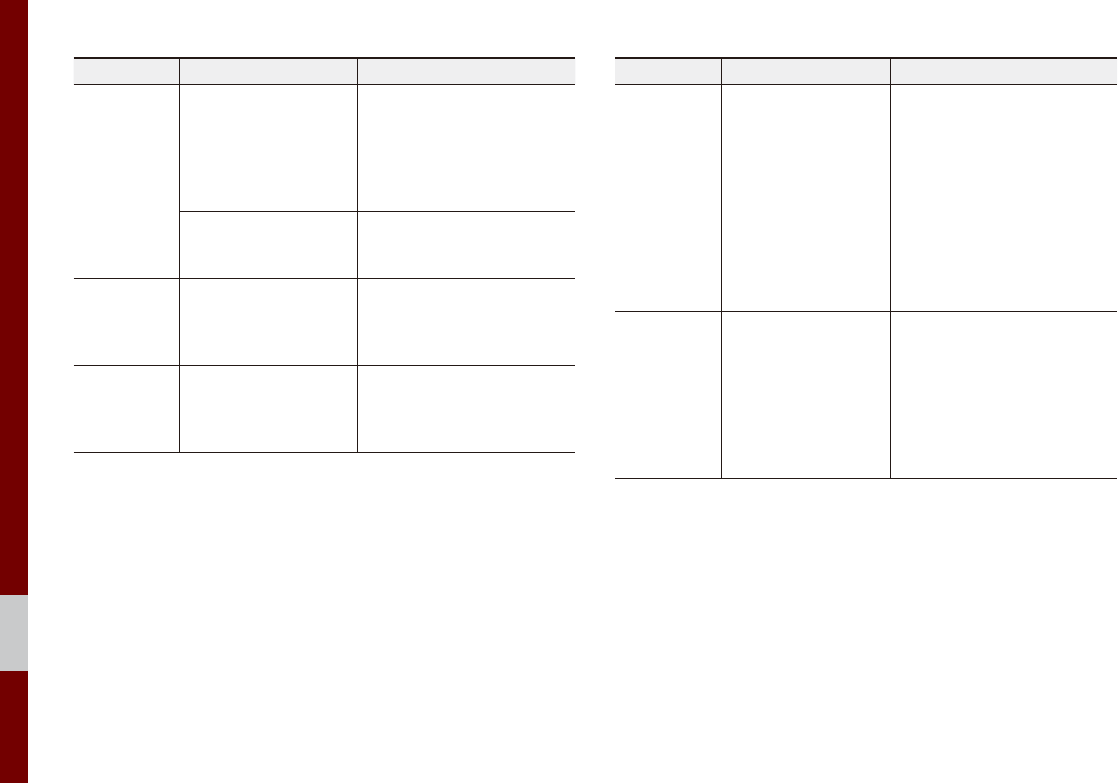
6-4 I Appendix
Problem Possible Cause Countermeasure
The power
does not
turn on
• The fuse is discon-
nected
• Replace with a suitable
fuse
• If the fuse is disconnected
again, please contact
your point of purchase or
Kia dealer
• Device is not prop-
erly connected
• Check to see that the
device has been properly
connected
The system
does not
play
• The vehicle battery
is low
• Charge the battery. If the
problem persists, contact
your point of purchase or
Kia dealer
The image
colour/tone
quality is
low
• The brightness,
saturation, hue, and
contrast levels are
not set properly
• Properly adjust the bright-
ness, saturation, hue, and
contrast levels through
Display Setup
Problem Possible Cause Countermeasure
Sound does
not work
• The volume level
is set to the lowest
level
• The connection is
not proper
• The device is cur-
rently fast-forward-
ing, rewinding,
scanning, or play-
ing in slow mode
• Adjust the volume level
• Check to see that the
device has been properly
connected
• The sound will not work
when the device is fast-for-
warding, rewinding, scan-
ning, or playing in slow
mode
The sound
or image
quality is
low
• Vibration is occur-
ring from where
the conversion
switch has been
installed
• Image colour/tone
quality is low
• The sound may be
short-circuited and the
image distorted if the
device vibrates
• The device will return to
normal once vibrations
stop
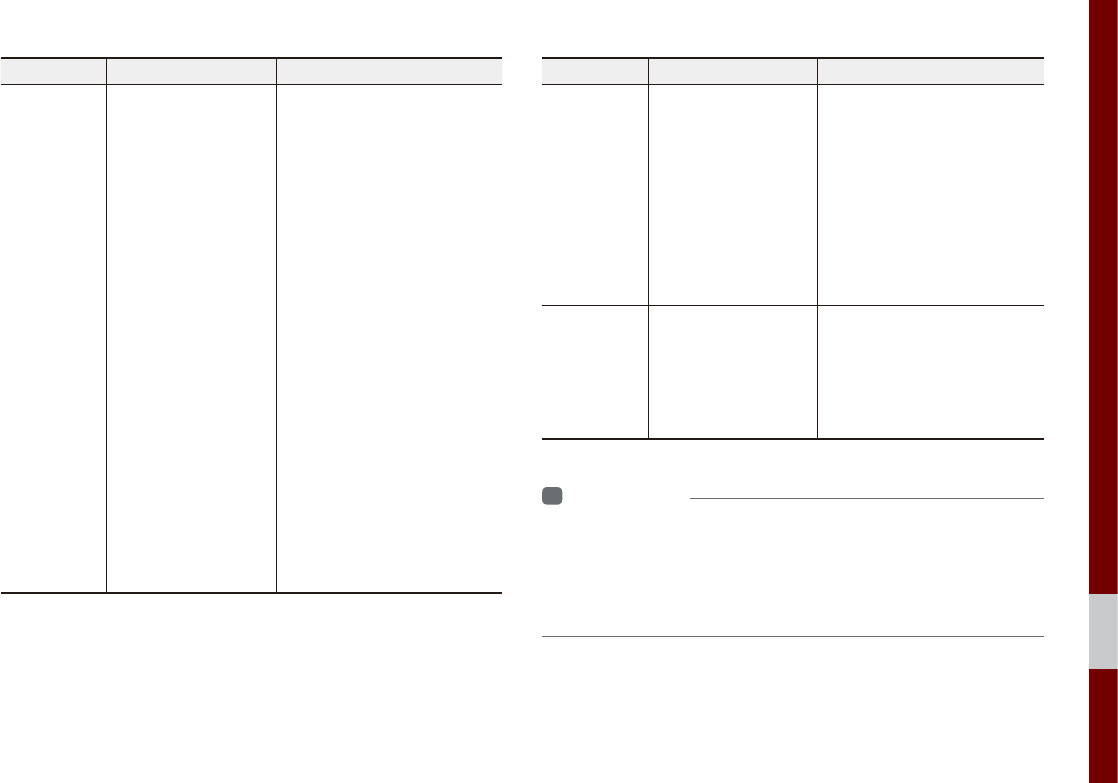
Troubleshooting I 6-5
06
Problem Possible Cause Countermeasure
The USB
does not
work
• USB memory is
damaged
• Please use the USB after
formatting it.
• USB memory has
been contaminated
• Remove any foreign sub-
stances on the contact sur-
face of the USB memory
and multimedia terminal
• A separately pur-
chased USB HUB
is being used
• Directly connect the USB
memory with the multime-
dia terminal on the vehicle
• A USB extension
cable is being
used
• Directly connect the USB
memory with the multime-
dia terminal on the vehicle
• A USB which is
not a Metal Cover
Type USB Memory
is being used
• Use standard USB Memory
• An HDD type, CF,
SD Memory is
being used
• Use standard USB Memory
• There are no
music files which
can be played
• Only MP3, WMA file for-
mats are supported. Please
use only the supported
music file formats
Problem Possible Cause Countermeasure
The iPod
is not rec-
ognised
even
though it
has been
connected
• There are no titles
which can be
played
• Use iTunes to download
and save MP3 files into the
iPod
• The iPod firmware
version has not
been properly
updated
• Use iTunes to update
the firmware version and
reconnect the iPod with the
device
• The iPod device
does not recog-
nise downloads
• Reset the iPod and recon-
nect with the device
Bluetooth
does not
work or its
limited func-
tions are
available
• Bluetooth on your
mobile phone is
set to OFF
• Set it to ON
• The Bluetooth
connection is not
made
• Make the connection active
i
Information
• While operating the device, if an abnormality occurs that cannot be
corrected with the above described measures, press the RESET key to
reset the system.
• Press and hold the RESET key (over 1 second). The device power will turn
off and the system will reset.

6-6 I Appendix
FAQ
About Pairing Mobile Phones
Q I cannot pair my mobile phone. What is the cause?
A Check to see that the mobile phone supports Bluetooth® func-
tion. Verify if Bluetooth on the cell phone is set to OFF. If so, set
it to ON. If the cell phone still can’t be registered, try again after
turning Bluetooth off and on, or delete the device registration on
the multimedia system and cell phone and then register the cell
phone again.
Q What is the difference between pairing a mobile phone and con-
necting a mobile phone?
A Pairing occurs through authenticating the head unit and mobile
phone. Mobile phones paired to the head unit can be connected
and disconnected until the paired mobile phone is deleted from
the system. Bluetooth® Handsfree features, such as making/
answering calls or managing contacts, are supported only in
mobile phones connected with the head unit.
Q What is a Passkey?
A A passkey is the password used to authenticate the connection
between the head unit and mobile phone. The passkey only
needs to be entered once when pairing the mobile phone for
the first time.
The initial passkey is 0000. You can change it with
SETUP
▶
Bluetooth
▶
System Bluetooth info
▶
Passkey
menu options.
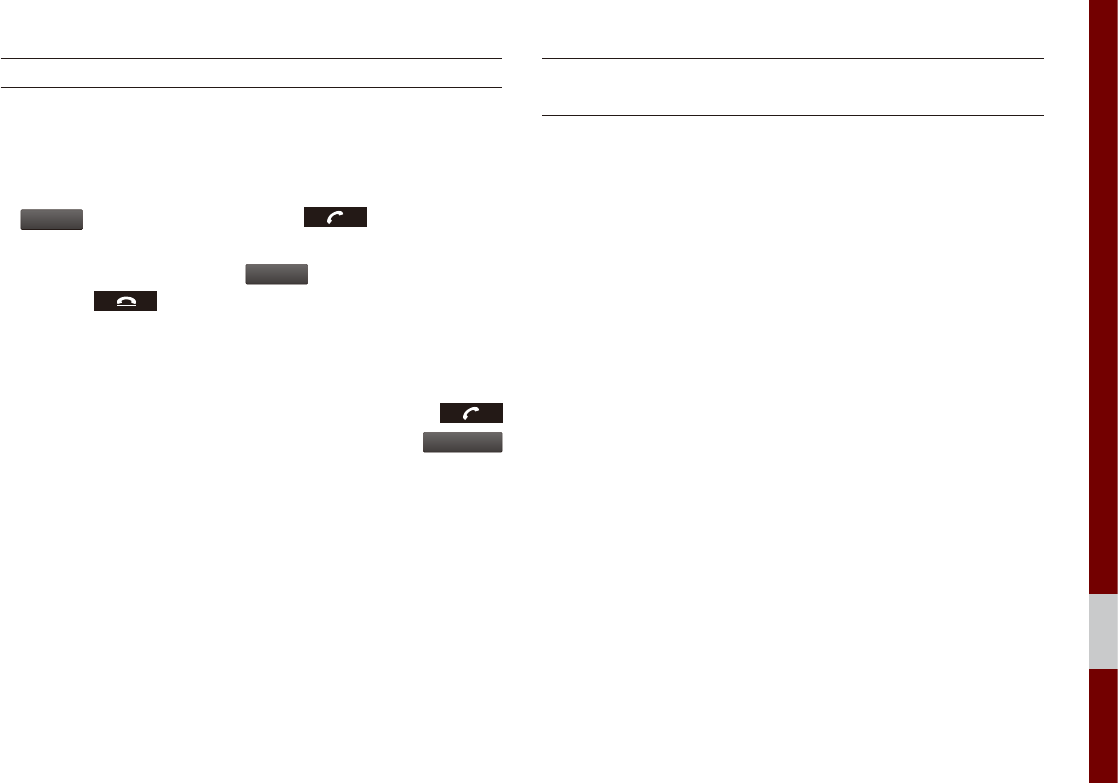
FAQ I 6-7
06
About Making/Answering Phone Calls
Q How can I answer a call?
A When there is an incoming call, a notification pop-up will
become displayed. To answer the incoming call, press the
Accept
button on the screen or the key on the steer-
ing remote controller.
To reject the call, press the
Reject
button on the screen or
press the key on the steering wheel control.
Q What should I do if I am talking on the Handsfree but want to
switch the call to the mobile phone?
A While on a call, press and hold (over 0.8 seconds) the
key on the steering remote controller or press the
Use private
button at the bottom of the Phone screen to switch the call to
your mobile phone.
About
Bluetooth
® Wireless Technology/
Multimedia System Use Environment
Q What is the range of my wireless connection?
A The wireless connection can be used within 15 yards.
Q How many mobile phones can be paired?
A It is possible to pair up to five mobile phones.
Q Why is call quality sometimes poor?
A
Check the reception sensitivity of the mobile phone when call
quality becomes worsened. The call quality may deteriorate when
the signal strength is low. Call quality may also worsen if metal
objects, such as beverage cans, are placed near the mobile
phone. Check to see if there are metal objects in the vicinity of
the mobile phone. The call sound and quality may differ depend-
ing on the type of mobile phone.

Important Safety Information
Before using your Multimedia system, read and follow all instructions and safety information provided in this end user manual ("User's
Guide"). Not following precautions found in this User's Guide can lead to an accident or other serious consequences.
Keep User's Guide in Vehicle
When kept in the vehicle, the User's Guide will be a ready reference for you and other users unfamiliar with the Multimedia system. Please
make certain that before using the system for the first time, all persons have access to the User's Guide and read its instructions and
safety information carefully.
Warning
Operating certain parts of this system while driving can distract your attention away from the road, and possibly cause an accident or other
serious consequences. Do not change system settings or enter data non-verbally (using your hands) while driving. Stop the vehicle in a
safe and legal manner before attempting these operations. This is important since while setting up or changing some functions as you may
to distract your attention away from the road and remove your hands from the wheel.

06
Prolonged Views of Screen
Do not access any function requiring a prolonged view of the screen while you are driving. Pull over in a safe and legal manner before
attempting to access a function of the system requiring prolonged attention. Even occasional short scans to the screen may be hazardous
if your attention has been diverted away from your driving task at a critical time.
Volume Setting
Do not raise the volume excessively. Keep the volume at a level where you can still hear outside traffic and emergency signals while
driving. Driving while unable to hear these sounds could cause an accident.
영어
FCC
FCC Part 15.19 Statements
This device complies with Part 15 of the FCC Rules. Operation is subject to the following two conditions:(1) this device may
not cause harmful interference, and (2) this device must accept any interference received, including interference that may
cause undesired operation.
FCC Part 15.21 statement
Any changes or modifications not expressly approved by the party responsible for compliance could void the user's authority to
operate this equipment.
RF Exposure Statement (MPE)
The antenna(s) must be installed such that a minimum separation distance of at least 20 cm is maintained between the
radiator (antenna) and all persons at all times.
This device must not be co-located or operating in conjunction with any other antenna or transm
영어
FCC Part 15.105 statement
This equipment has been tested and found to comply with the limits for a Class B digital device, pursuant to part 15 of the FCC
Rules.
These limits are designed to provide reasonable protection against harmful interference in a residential installation. This
equipment generates, uses and can radiate radio frequency energy and, if not installed and used in accordance with the
instructions, may cause harmful interference to radio communications. However, there is no guarantee that interference will not
occur in a particular installation. If this equipment does cause harmful interference to radio or television reception, which can be
determined by turning the equipment off and on, the user is encouraged to try to correct the interference by one or more of the
following measures:
- Reorient or relocate the receiving antenna.
- Increase the separation between the equipment and receiver.
- Connect the equipment into an outlet on a circuit different from that to which the receiver is connected.
- Consult the dealer or an experienced radio/TV technician for help.
영어
,&:DUQLQJ
This device complies with Industry Canada license-exempt RSS standard(s). Operation is subject to the following two conditions: (1) This
device may not cause interference; and (2) This device must accept any interference, including interference that may cause undesired
operation of the device.
Le présent appareil est conforme aux CNR d’Industrie Canada applicables aux appareils radio exempts de licence. L’exploitation est
autorisée aux deux conditions suivantes : (1) l’appareil ne doit pas produire de brouillage, et (2) l’utilisateur de l’appareil doit accepter tout
brouillage radioélectrique subi, même si le brouillage est susceptible d’en compromettre le fonctionnement.
RF Exposure
The antenna (or antennas) must be installed so as to maintain at all times a distance minimum of at least 20 cm between the radiation
source (antenna) and any individual. This device may not be installed or used in conjunction with any other antenna or transmitter.
l’exposition aux RF
L’antenne (ou les antennes) doit tre install e de fa on maintenir tout instant une distance minimum de au moins 20 cm entre la source de
radiation (l’antenne) et toute personne physique.


